Leadership and Organisation Assignment
VerifiedAdded on 2021/01/01
|19
|6509
|280
AI Summary
Contribute Materials
Your contribution can guide someone’s learning journey. Share your
documents today.

Leadership and Organisation
Secure Best Marks with AI Grader
Need help grading? Try our AI Grader for instant feedback on your assignments.
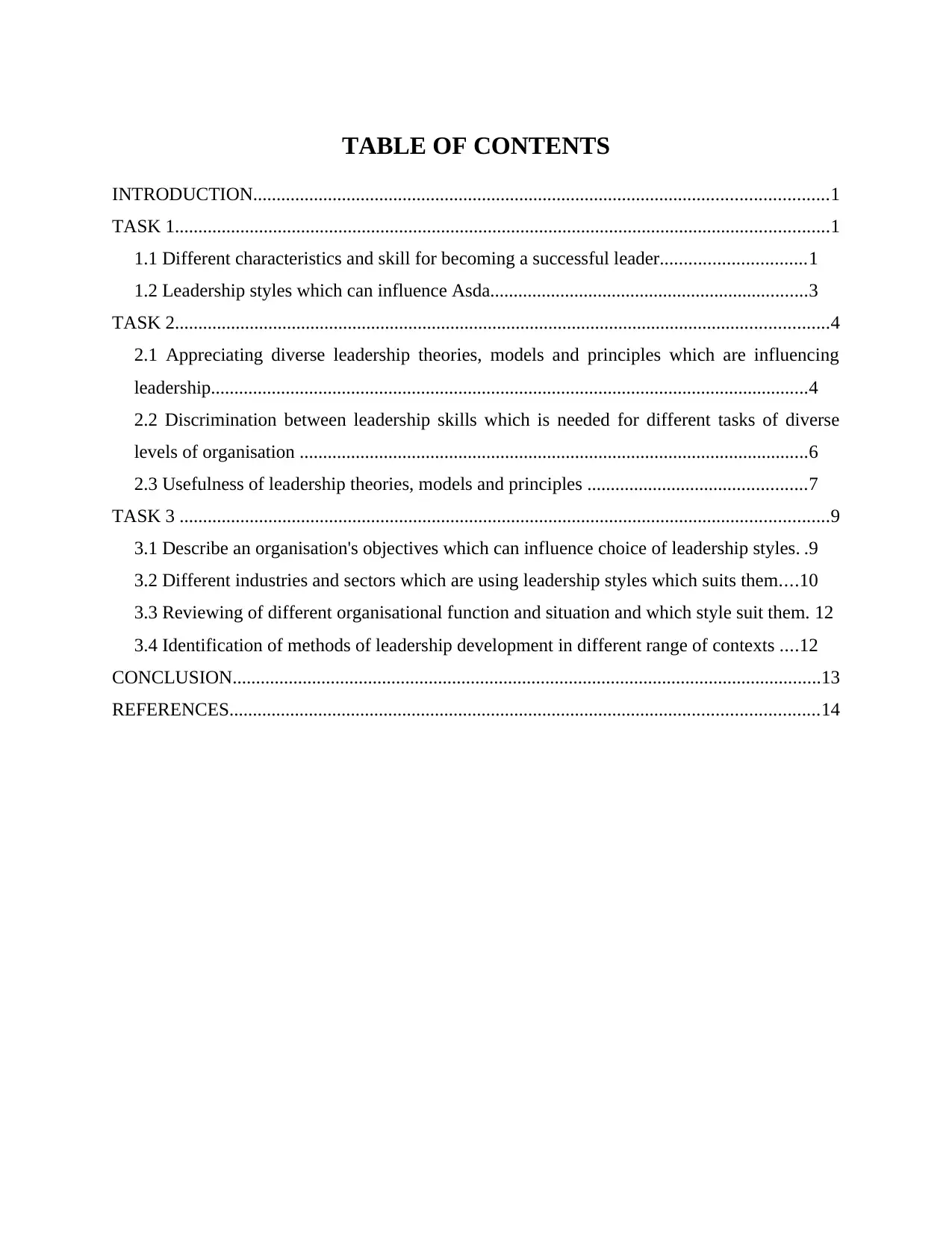
TABLE OF CONTENTS
INTRODUCTION...........................................................................................................................1
TASK 1............................................................................................................................................1
1.1 Different characteristics and skill for becoming a successful leader...............................1
1.2 Leadership styles which can influence Asda....................................................................3
TASK 2............................................................................................................................................4
2.1 Appreciating diverse leadership theories, models and principles which are influencing
leadership................................................................................................................................4
2.2 Discrimination between leadership skills which is needed for different tasks of diverse
levels of organisation .............................................................................................................6
2.3 Usefulness of leadership theories, models and principles ...............................................7
TASK 3 ...........................................................................................................................................9
3.1 Describe an organisation's objectives which can influence choice of leadership styles. .9
3.2 Different industries and sectors which are using leadership styles which suits them....10
3.3 Reviewing of different organisational function and situation and which style suit them. 12
3.4 Identification of methods of leadership development in different range of contexts ....12
CONCLUSION..............................................................................................................................13
REFERENCES..............................................................................................................................14
INTRODUCTION...........................................................................................................................1
TASK 1............................................................................................................................................1
1.1 Different characteristics and skill for becoming a successful leader...............................1
1.2 Leadership styles which can influence Asda....................................................................3
TASK 2............................................................................................................................................4
2.1 Appreciating diverse leadership theories, models and principles which are influencing
leadership................................................................................................................................4
2.2 Discrimination between leadership skills which is needed for different tasks of diverse
levels of organisation .............................................................................................................6
2.3 Usefulness of leadership theories, models and principles ...............................................7
TASK 3 ...........................................................................................................................................9
3.1 Describe an organisation's objectives which can influence choice of leadership styles. .9
3.2 Different industries and sectors which are using leadership styles which suits them....10
3.3 Reviewing of different organisational function and situation and which style suit them. 12
3.4 Identification of methods of leadership development in different range of contexts ....12
CONCLUSION..............................................................................................................................13
REFERENCES..............................................................................................................................14
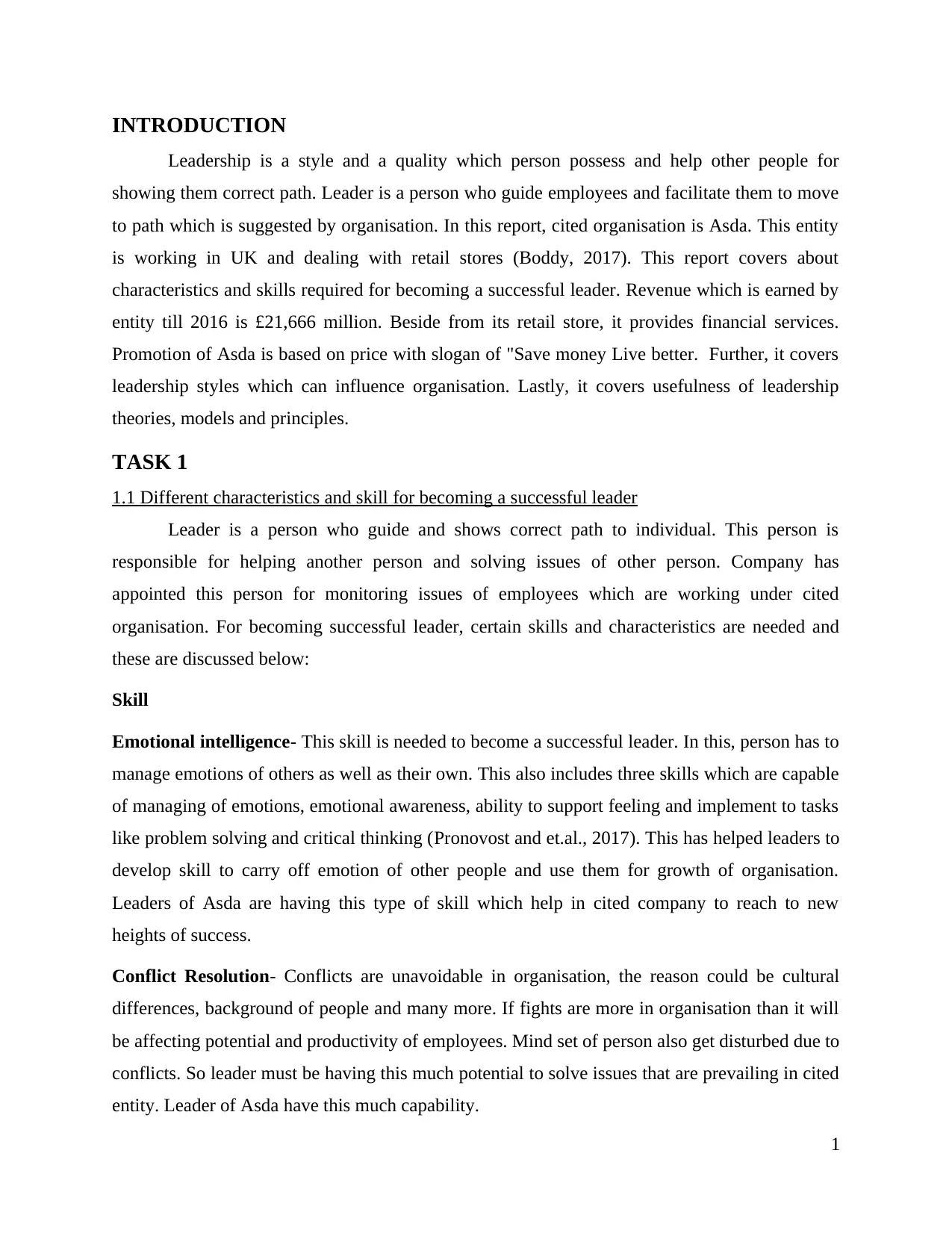
INTRODUCTION
Leadership is a style and a quality which person possess and help other people for
showing them correct path. Leader is a person who guide employees and facilitate them to move
to path which is suggested by organisation. In this report, cited organisation is Asda. This entity
is working in UK and dealing with retail stores (Boddy, 2017). This report covers about
characteristics and skills required for becoming a successful leader. Revenue which is earned by
entity till 2016 is £21,666 million. Beside from its retail store, it provides financial services.
Promotion of Asda is based on price with slogan of "Save money Live better. Further, it covers
leadership styles which can influence organisation. Lastly, it covers usefulness of leadership
theories, models and principles.
TASK 1
1.1 Different characteristics and skill for becoming a successful leader
Leader is a person who guide and shows correct path to individual. This person is
responsible for helping another person and solving issues of other person. Company has
appointed this person for monitoring issues of employees which are working under cited
organisation. For becoming successful leader, certain skills and characteristics are needed and
these are discussed below:
Skill
Emotional intelligence- This skill is needed to become a successful leader. In this, person has to
manage emotions of others as well as their own. This also includes three skills which are capable
of managing of emotions, emotional awareness, ability to support feeling and implement to tasks
like problem solving and critical thinking (Pronovost and et.al., 2017). This has helped leaders to
develop skill to carry off emotion of other people and use them for growth of organisation.
Leaders of Asda are having this type of skill which help in cited company to reach to new
heights of success.
Conflict Resolution- Conflicts are unavoidable in organisation, the reason could be cultural
differences, background of people and many more. If fights are more in organisation than it will
be affecting potential and productivity of employees. Mind set of person also get disturbed due to
conflicts. So leader must be having this much potential to solve issues that are prevailing in cited
entity. Leader of Asda have this much capability.
1
Leadership is a style and a quality which person possess and help other people for
showing them correct path. Leader is a person who guide employees and facilitate them to move
to path which is suggested by organisation. In this report, cited organisation is Asda. This entity
is working in UK and dealing with retail stores (Boddy, 2017). This report covers about
characteristics and skills required for becoming a successful leader. Revenue which is earned by
entity till 2016 is £21,666 million. Beside from its retail store, it provides financial services.
Promotion of Asda is based on price with slogan of "Save money Live better. Further, it covers
leadership styles which can influence organisation. Lastly, it covers usefulness of leadership
theories, models and principles.
TASK 1
1.1 Different characteristics and skill for becoming a successful leader
Leader is a person who guide and shows correct path to individual. This person is
responsible for helping another person and solving issues of other person. Company has
appointed this person for monitoring issues of employees which are working under cited
organisation. For becoming successful leader, certain skills and characteristics are needed and
these are discussed below:
Skill
Emotional intelligence- This skill is needed to become a successful leader. In this, person has to
manage emotions of others as well as their own. This also includes three skills which are capable
of managing of emotions, emotional awareness, ability to support feeling and implement to tasks
like problem solving and critical thinking (Pronovost and et.al., 2017). This has helped leaders to
develop skill to carry off emotion of other people and use them for growth of organisation.
Leaders of Asda are having this type of skill which help in cited company to reach to new
heights of success.
Conflict Resolution- Conflicts are unavoidable in organisation, the reason could be cultural
differences, background of people and many more. If fights are more in organisation than it will
be affecting potential and productivity of employees. Mind set of person also get disturbed due to
conflicts. So leader must be having this much potential to solve issues that are prevailing in cited
entity. Leader of Asda have this much capability.
1
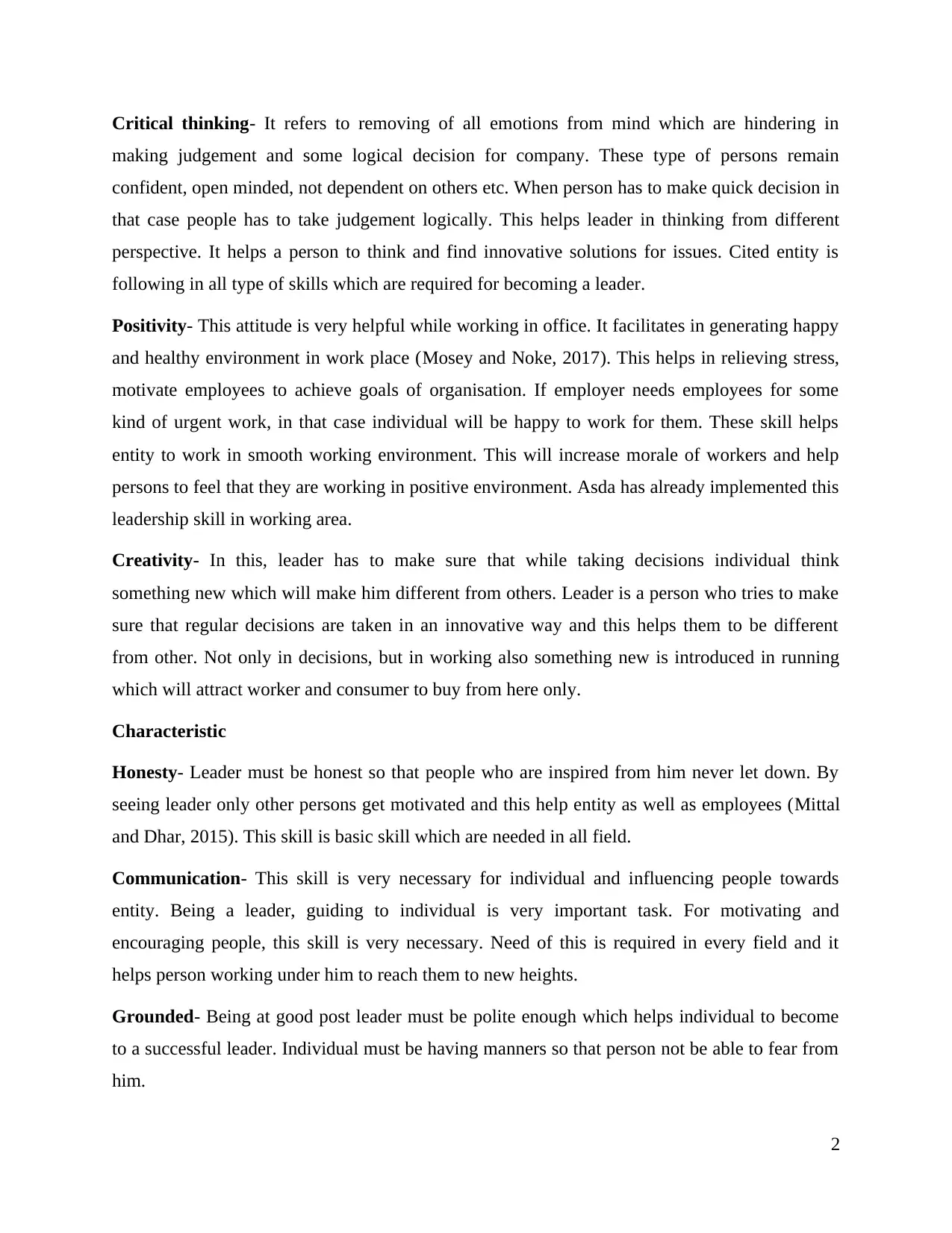
Critical thinking- It refers to removing of all emotions from mind which are hindering in
making judgement and some logical decision for company. These type of persons remain
confident, open minded, not dependent on others etc. When person has to make quick decision in
that case people has to take judgement logically. This helps leader in thinking from different
perspective. It helps a person to think and find innovative solutions for issues. Cited entity is
following in all type of skills which are required for becoming a leader.
Positivity- This attitude is very helpful while working in office. It facilitates in generating happy
and healthy environment in work place (Mosey and Noke, 2017). This helps in relieving stress,
motivate employees to achieve goals of organisation. If employer needs employees for some
kind of urgent work, in that case individual will be happy to work for them. These skill helps
entity to work in smooth working environment. This will increase morale of workers and help
persons to feel that they are working in positive environment. Asda has already implemented this
leadership skill in working area.
Creativity- In this, leader has to make sure that while taking decisions individual think
something new which will make him different from others. Leader is a person who tries to make
sure that regular decisions are taken in an innovative way and this helps them to be different
from other. Not only in decisions, but in working also something new is introduced in running
which will attract worker and consumer to buy from here only.
Characteristic
Honesty- Leader must be honest so that people who are inspired from him never let down. By
seeing leader only other persons get motivated and this help entity as well as employees (Mittal
and Dhar, 2015). This skill is basic skill which are needed in all field.
Communication- This skill is very necessary for individual and influencing people towards
entity. Being a leader, guiding to individual is very important task. For motivating and
encouraging people, this skill is very necessary. Need of this is required in every field and it
helps person working under him to reach them to new heights.
Grounded- Being at good post leader must be polite enough which helps individual to become
to a successful leader. Individual must be having manners so that person not be able to fear from
him.
2
making judgement and some logical decision for company. These type of persons remain
confident, open minded, not dependent on others etc. When person has to make quick decision in
that case people has to take judgement logically. This helps leader in thinking from different
perspective. It helps a person to think and find innovative solutions for issues. Cited entity is
following in all type of skills which are required for becoming a leader.
Positivity- This attitude is very helpful while working in office. It facilitates in generating happy
and healthy environment in work place (Mosey and Noke, 2017). This helps in relieving stress,
motivate employees to achieve goals of organisation. If employer needs employees for some
kind of urgent work, in that case individual will be happy to work for them. These skill helps
entity to work in smooth working environment. This will increase morale of workers and help
persons to feel that they are working in positive environment. Asda has already implemented this
leadership skill in working area.
Creativity- In this, leader has to make sure that while taking decisions individual think
something new which will make him different from others. Leader is a person who tries to make
sure that regular decisions are taken in an innovative way and this helps them to be different
from other. Not only in decisions, but in working also something new is introduced in running
which will attract worker and consumer to buy from here only.
Characteristic
Honesty- Leader must be honest so that people who are inspired from him never let down. By
seeing leader only other persons get motivated and this help entity as well as employees (Mittal
and Dhar, 2015). This skill is basic skill which are needed in all field.
Communication- This skill is very necessary for individual and influencing people towards
entity. Being a leader, guiding to individual is very important task. For motivating and
encouraging people, this skill is very necessary. Need of this is required in every field and it
helps person working under him to reach them to new heights.
Grounded- Being at good post leader must be polite enough which helps individual to become
to a successful leader. Individual must be having manners so that person not be able to fear from
him.
2
Secure Best Marks with AI Grader
Need help grading? Try our AI Grader for instant feedback on your assignments.
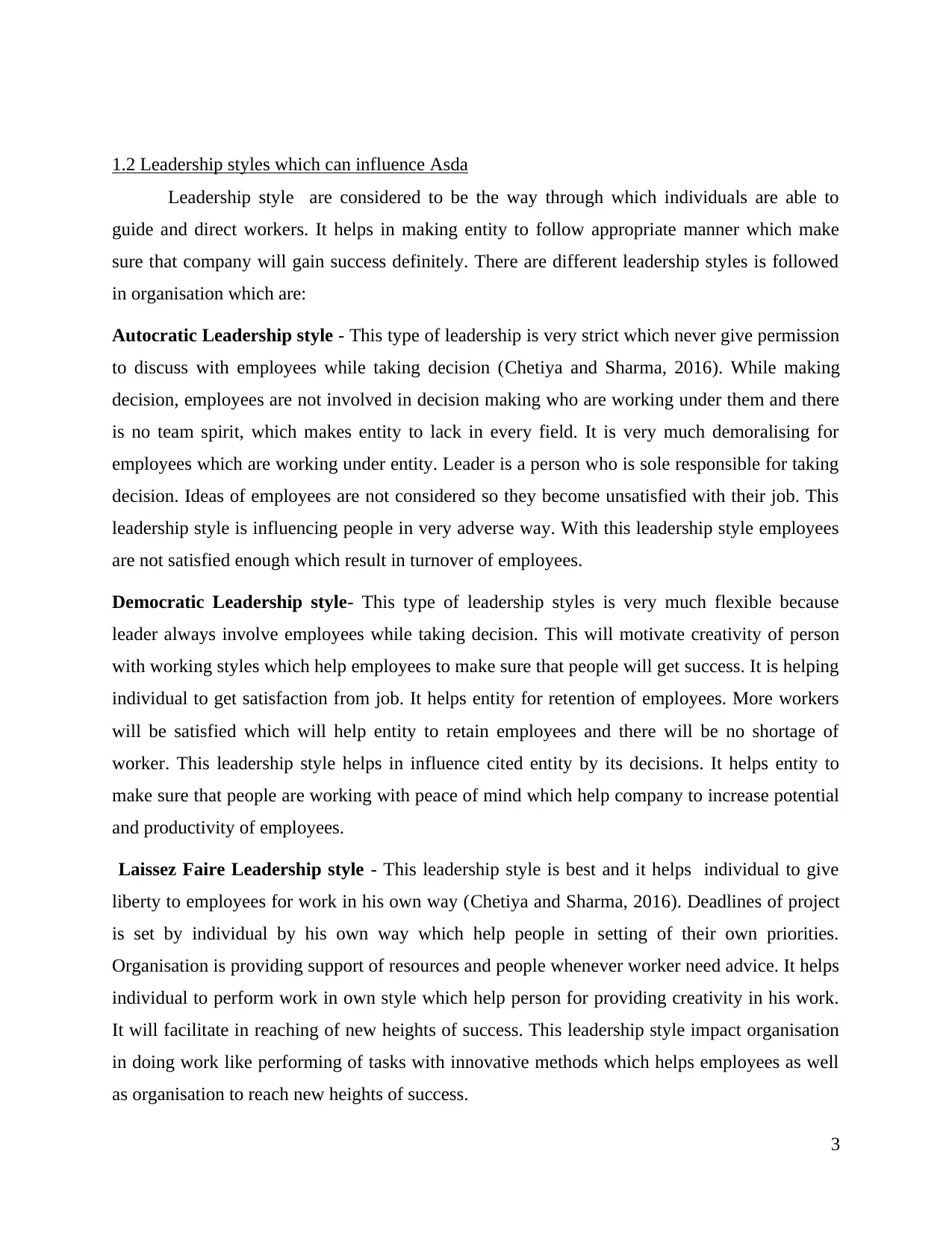
1.2 Leadership styles which can influence Asda
Leadership style are considered to be the way through which individuals are able to
guide and direct workers. It helps in making entity to follow appropriate manner which make
sure that company will gain success definitely. There are different leadership styles is followed
in organisation which are:
Autocratic Leadership style - This type of leadership is very strict which never give permission
to discuss with employees while taking decision (Chetiya and Sharma, 2016). While making
decision, employees are not involved in decision making who are working under them and there
is no team spirit, which makes entity to lack in every field. It is very much demoralising for
employees which are working under entity. Leader is a person who is sole responsible for taking
decision. Ideas of employees are not considered so they become unsatisfied with their job. This
leadership style is influencing people in very adverse way. With this leadership style employees
are not satisfied enough which result in turnover of employees.
Democratic Leadership style- This type of leadership styles is very much flexible because
leader always involve employees while taking decision. This will motivate creativity of person
with working styles which help employees to make sure that people will get success. It is helping
individual to get satisfaction from job. It helps entity for retention of employees. More workers
will be satisfied which will help entity to retain employees and there will be no shortage of
worker. This leadership style helps in influence cited entity by its decisions. It helps entity to
make sure that people are working with peace of mind which help company to increase potential
and productivity of employees.
Laissez Faire Leadership style - This leadership style is best and it helps individual to give
liberty to employees for work in his own way (Chetiya and Sharma, 2016). Deadlines of project
is set by individual by his own way which help people in setting of their own priorities.
Organisation is providing support of resources and people whenever worker need advice. It helps
individual to perform work in own style which help person for providing creativity in his work.
It will facilitate in reaching of new heights of success. This leadership style impact organisation
in doing work like performing of tasks with innovative methods which helps employees as well
as organisation to reach new heights of success.
3
Leadership style are considered to be the way through which individuals are able to
guide and direct workers. It helps in making entity to follow appropriate manner which make
sure that company will gain success definitely. There are different leadership styles is followed
in organisation which are:
Autocratic Leadership style - This type of leadership is very strict which never give permission
to discuss with employees while taking decision (Chetiya and Sharma, 2016). While making
decision, employees are not involved in decision making who are working under them and there
is no team spirit, which makes entity to lack in every field. It is very much demoralising for
employees which are working under entity. Leader is a person who is sole responsible for taking
decision. Ideas of employees are not considered so they become unsatisfied with their job. This
leadership style is influencing people in very adverse way. With this leadership style employees
are not satisfied enough which result in turnover of employees.
Democratic Leadership style- This type of leadership styles is very much flexible because
leader always involve employees while taking decision. This will motivate creativity of person
with working styles which help employees to make sure that people will get success. It is helping
individual to get satisfaction from job. It helps entity for retention of employees. More workers
will be satisfied which will help entity to retain employees and there will be no shortage of
worker. This leadership style helps in influence cited entity by its decisions. It helps entity to
make sure that people are working with peace of mind which help company to increase potential
and productivity of employees.
Laissez Faire Leadership style - This leadership style is best and it helps individual to give
liberty to employees for work in his own way (Chetiya and Sharma, 2016). Deadlines of project
is set by individual by his own way which help people in setting of their own priorities.
Organisation is providing support of resources and people whenever worker need advice. It helps
individual to perform work in own style which help person for providing creativity in his work.
It will facilitate in reaching of new heights of success. This leadership style impact organisation
in doing work like performing of tasks with innovative methods which helps employees as well
as organisation to reach new heights of success.
3
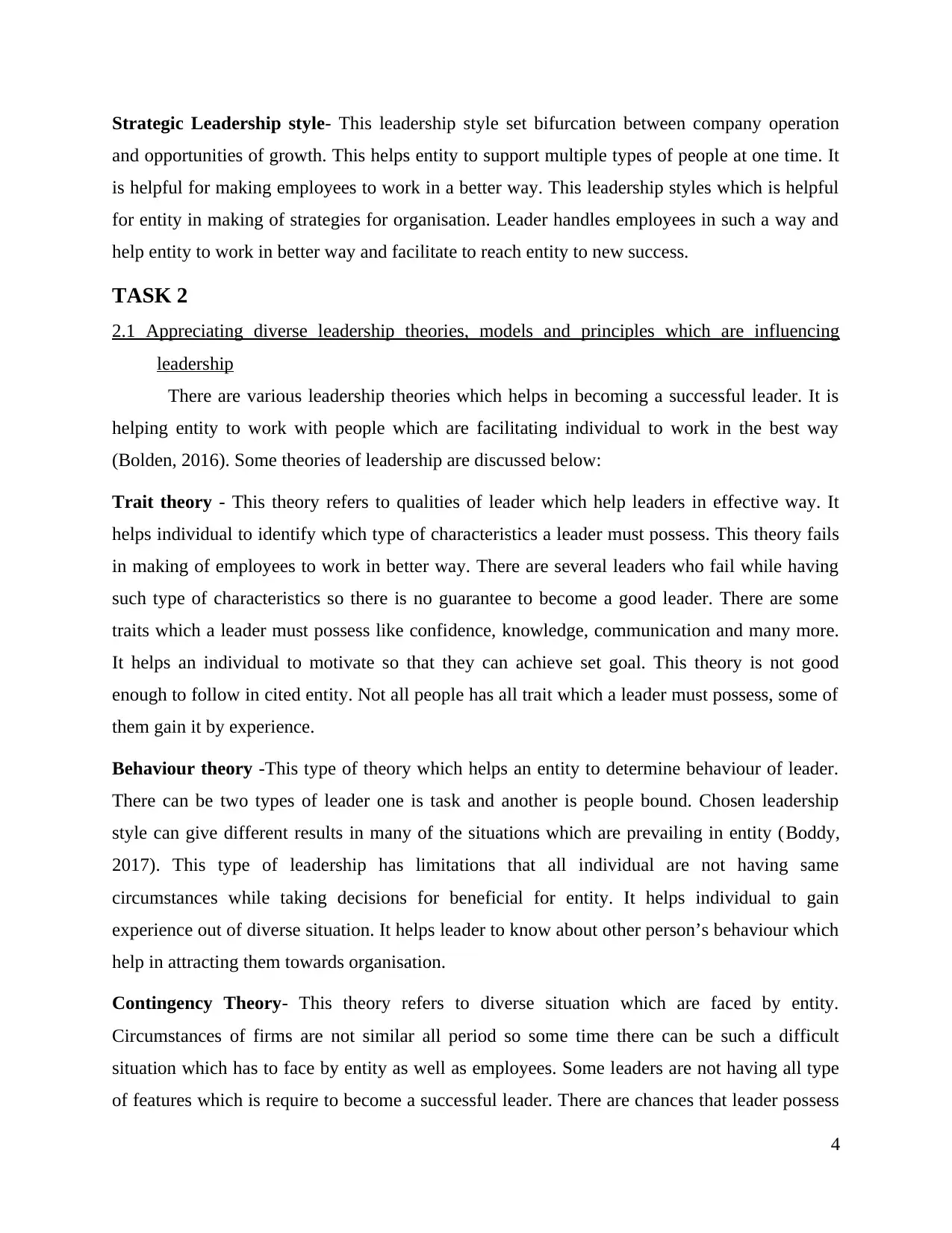
Strategic Leadership style- This leadership style set bifurcation between company operation
and opportunities of growth. This helps entity to support multiple types of people at one time. It
is helpful for making employees to work in a better way. This leadership styles which is helpful
for entity in making of strategies for organisation. Leader handles employees in such a way and
help entity to work in better way and facilitate to reach entity to new success.
TASK 2
2.1 Appreciating diverse leadership theories, models and principles which are influencing
leadership
There are various leadership theories which helps in becoming a successful leader. It is
helping entity to work with people which are facilitating individual to work in the best way
(Bolden, 2016). Some theories of leadership are discussed below:
Trait theory - This theory refers to qualities of leader which help leaders in effective way. It
helps individual to identify which type of characteristics a leader must possess. This theory fails
in making of employees to work in better way. There are several leaders who fail while having
such type of characteristics so there is no guarantee to become a good leader. There are some
traits which a leader must possess like confidence, knowledge, communication and many more.
It helps an individual to motivate so that they can achieve set goal. This theory is not good
enough to follow in cited entity. Not all people has all trait which a leader must possess, some of
them gain it by experience.
Behaviour theory -This type of theory which helps an entity to determine behaviour of leader.
There can be two types of leader one is task and another is people bound. Chosen leadership
style can give different results in many of the situations which are prevailing in entity (Boddy,
2017). This type of leadership has limitations that all individual are not having same
circumstances while taking decisions for beneficial for entity. It helps individual to gain
experience out of diverse situation. It helps leader to know about other person’s behaviour which
help in attracting them towards organisation.
Contingency Theory- This theory refers to diverse situation which are faced by entity.
Circumstances of firms are not similar all period so some time there can be such a difficult
situation which has to face by entity as well as employees. Some leaders are not having all type
of features which is require to become a successful leader. There are chances that leader possess
4
and opportunities of growth. This helps entity to support multiple types of people at one time. It
is helpful for making employees to work in a better way. This leadership styles which is helpful
for entity in making of strategies for organisation. Leader handles employees in such a way and
help entity to work in better way and facilitate to reach entity to new success.
TASK 2
2.1 Appreciating diverse leadership theories, models and principles which are influencing
leadership
There are various leadership theories which helps in becoming a successful leader. It is
helping entity to work with people which are facilitating individual to work in the best way
(Bolden, 2016). Some theories of leadership are discussed below:
Trait theory - This theory refers to qualities of leader which help leaders in effective way. It
helps individual to identify which type of characteristics a leader must possess. This theory fails
in making of employees to work in better way. There are several leaders who fail while having
such type of characteristics so there is no guarantee to become a good leader. There are some
traits which a leader must possess like confidence, knowledge, communication and many more.
It helps an individual to motivate so that they can achieve set goal. This theory is not good
enough to follow in cited entity. Not all people has all trait which a leader must possess, some of
them gain it by experience.
Behaviour theory -This type of theory which helps an entity to determine behaviour of leader.
There can be two types of leader one is task and another is people bound. Chosen leadership
style can give different results in many of the situations which are prevailing in entity (Boddy,
2017). This type of leadership has limitations that all individual are not having same
circumstances while taking decisions for beneficial for entity. It helps individual to gain
experience out of diverse situation. It helps leader to know about other person’s behaviour which
help in attracting them towards organisation.
Contingency Theory- This theory refers to diverse situation which are faced by entity.
Circumstances of firms are not similar all period so some time there can be such a difficult
situation which has to face by entity as well as employees. Some leaders are not having all type
of features which is require to become a successful leader. There are chances that leader possess
4
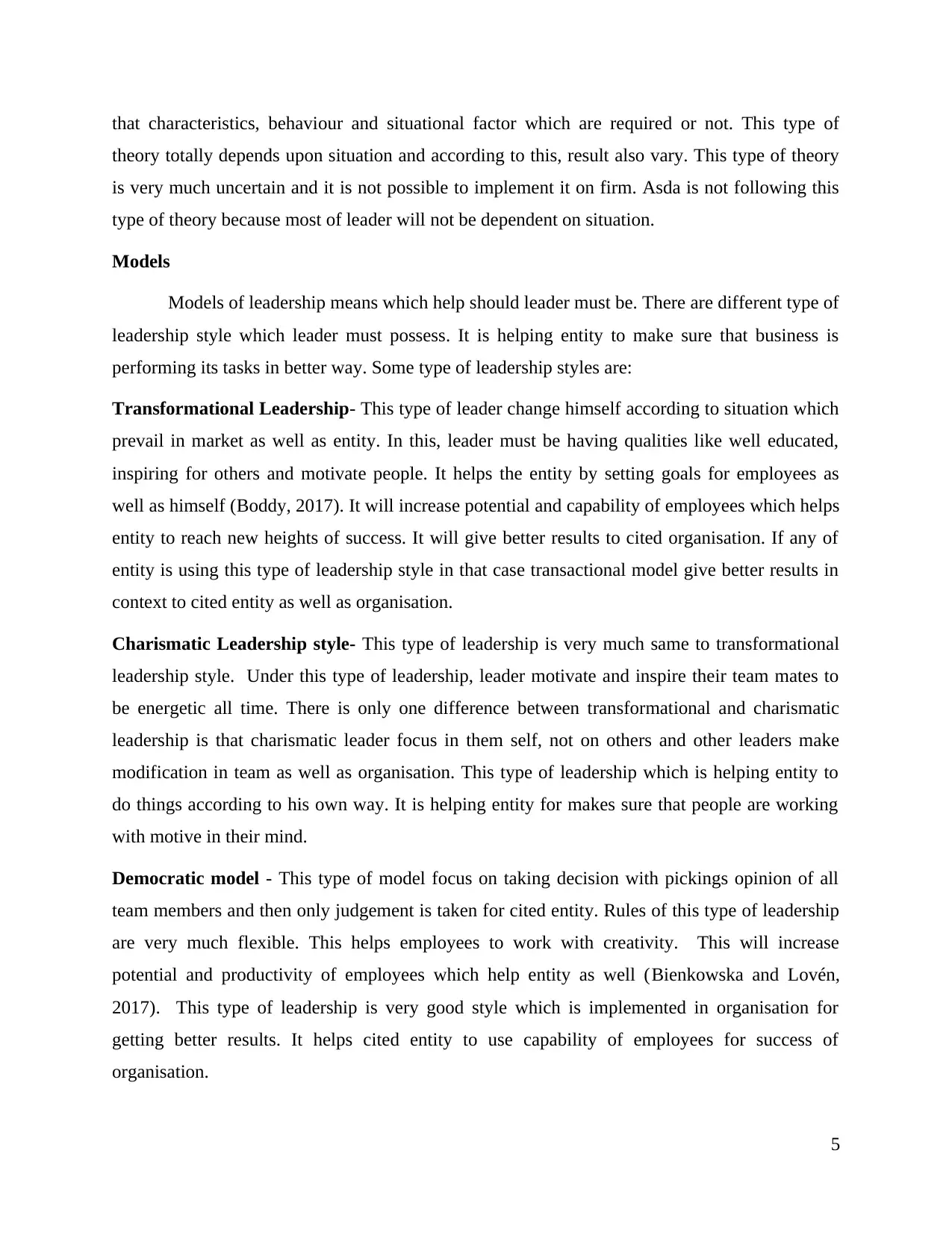
that characteristics, behaviour and situational factor which are required or not. This type of
theory totally depends upon situation and according to this, result also vary. This type of theory
is very much uncertain and it is not possible to implement it on firm. Asda is not following this
type of theory because most of leader will not be dependent on situation.
Models
Models of leadership means which help should leader must be. There are different type of
leadership style which leader must possess. It is helping entity to make sure that business is
performing its tasks in better way. Some type of leadership styles are:
Transformational Leadership- This type of leader change himself according to situation which
prevail in market as well as entity. In this, leader must be having qualities like well educated,
inspiring for others and motivate people. It helps the entity by setting goals for employees as
well as himself (Boddy, 2017). It will increase potential and capability of employees which helps
entity to reach new heights of success. It will give better results to cited organisation. If any of
entity is using this type of leadership style in that case transactional model give better results in
context to cited entity as well as organisation.
Charismatic Leadership style- This type of leadership is very much same to transformational
leadership style. Under this type of leadership, leader motivate and inspire their team mates to
be energetic all time. There is only one difference between transformational and charismatic
leadership is that charismatic leader focus in them self, not on others and other leaders make
modification in team as well as organisation. This type of leadership which is helping entity to
do things according to his own way. It is helping entity for makes sure that people are working
with motive in their mind.
Democratic model - This type of model focus on taking decision with pickings opinion of all
team members and then only judgement is taken for cited entity. Rules of this type of leadership
are very much flexible. This helps employees to work with creativity. This will increase
potential and productivity of employees which help entity as well (Bienkowska and Lovén,
2017). This type of leadership is very good style which is implemented in organisation for
getting better results. It helps cited entity to use capability of employees for success of
organisation.
5
theory totally depends upon situation and according to this, result also vary. This type of theory
is very much uncertain and it is not possible to implement it on firm. Asda is not following this
type of theory because most of leader will not be dependent on situation.
Models
Models of leadership means which help should leader must be. There are different type of
leadership style which leader must possess. It is helping entity to make sure that business is
performing its tasks in better way. Some type of leadership styles are:
Transformational Leadership- This type of leader change himself according to situation which
prevail in market as well as entity. In this, leader must be having qualities like well educated,
inspiring for others and motivate people. It helps the entity by setting goals for employees as
well as himself (Boddy, 2017). It will increase potential and capability of employees which helps
entity to reach new heights of success. It will give better results to cited organisation. If any of
entity is using this type of leadership style in that case transactional model give better results in
context to cited entity as well as organisation.
Charismatic Leadership style- This type of leadership is very much same to transformational
leadership style. Under this type of leadership, leader motivate and inspire their team mates to
be energetic all time. There is only one difference between transformational and charismatic
leadership is that charismatic leader focus in them self, not on others and other leaders make
modification in team as well as organisation. This type of leadership which is helping entity to
do things according to his own way. It is helping entity for makes sure that people are working
with motive in their mind.
Democratic model - This type of model focus on taking decision with pickings opinion of all
team members and then only judgement is taken for cited entity. Rules of this type of leadership
are very much flexible. This helps employees to work with creativity. This will increase
potential and productivity of employees which help entity as well (Bienkowska and Lovén,
2017). This type of leadership is very good style which is implemented in organisation for
getting better results. It helps cited entity to use capability of employees for success of
organisation.
5
Paraphrase This Document
Need a fresh take? Get an instant paraphrase of this document with our AI Paraphraser
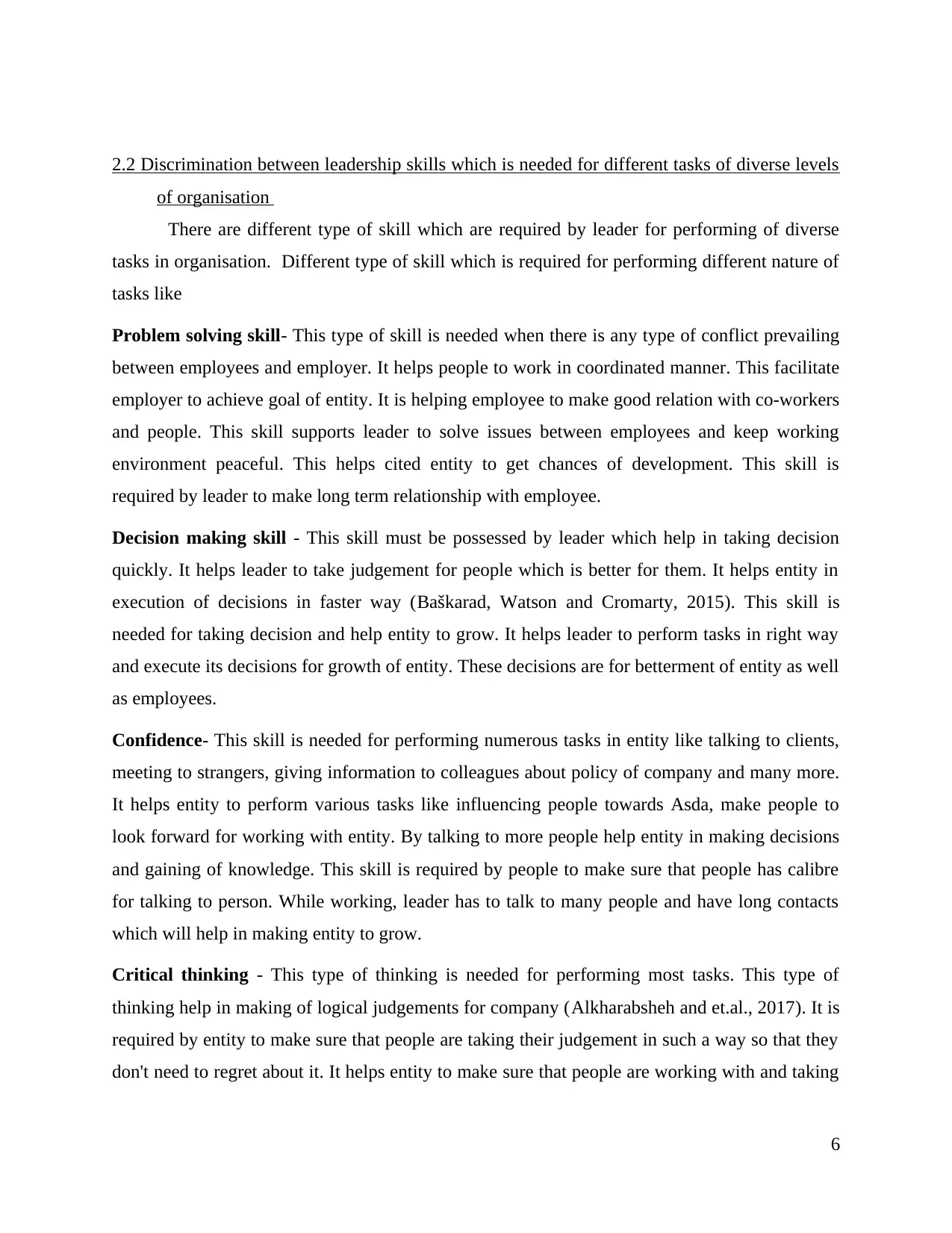
2.2 Discrimination between leadership skills which is needed for different tasks of diverse levels
of organisation
There are different type of skill which are required by leader for performing of diverse
tasks in organisation. Different type of skill which is required for performing different nature of
tasks like
Problem solving skill- This type of skill is needed when there is any type of conflict prevailing
between employees and employer. It helps people to work in coordinated manner. This facilitate
employer to achieve goal of entity. It is helping employee to make good relation with co-workers
and people. This skill supports leader to solve issues between employees and keep working
environment peaceful. This helps cited entity to get chances of development. This skill is
required by leader to make long term relationship with employee.
Decision making skill - This skill must be possessed by leader which help in taking decision
quickly. It helps leader to take judgement for people which is better for them. It helps entity in
execution of decisions in faster way (Baškarad, Watson and Cromarty, 2015). This skill is
needed for taking decision and help entity to grow. It helps leader to perform tasks in right way
and execute its decisions for growth of entity. These decisions are for betterment of entity as well
as employees.
Confidence- This skill is needed for performing numerous tasks in entity like talking to clients,
meeting to strangers, giving information to colleagues about policy of company and many more.
It helps entity to perform various tasks like influencing people towards Asda, make people to
look forward for working with entity. By talking to more people help entity in making decisions
and gaining of knowledge. This skill is required by people to make sure that people has calibre
for talking to person. While working, leader has to talk to many people and have long contacts
which will help in making entity to grow.
Critical thinking - This type of thinking is needed for performing most tasks. This type of
thinking help in making of logical judgements for company (Alkharabsheh and et.al., 2017). It is
required by entity to make sure that people are taking their judgement in such a way so that they
don't need to regret about it. It helps entity to make sure that people are working with and taking
6
of organisation
There are different type of skill which are required by leader for performing of diverse
tasks in organisation. Different type of skill which is required for performing different nature of
tasks like
Problem solving skill- This type of skill is needed when there is any type of conflict prevailing
between employees and employer. It helps people to work in coordinated manner. This facilitate
employer to achieve goal of entity. It is helping employee to make good relation with co-workers
and people. This skill supports leader to solve issues between employees and keep working
environment peaceful. This helps cited entity to get chances of development. This skill is
required by leader to make long term relationship with employee.
Decision making skill - This skill must be possessed by leader which help in taking decision
quickly. It helps leader to take judgement for people which is better for them. It helps entity in
execution of decisions in faster way (Baškarad, Watson and Cromarty, 2015). This skill is
needed for taking decision and help entity to grow. It helps leader to perform tasks in right way
and execute its decisions for growth of entity. These decisions are for betterment of entity as well
as employees.
Confidence- This skill is needed for performing numerous tasks in entity like talking to clients,
meeting to strangers, giving information to colleagues about policy of company and many more.
It helps entity to perform various tasks like influencing people towards Asda, make people to
look forward for working with entity. By talking to more people help entity in making decisions
and gaining of knowledge. This skill is required by people to make sure that people has calibre
for talking to person. While working, leader has to talk to many people and have long contacts
which will help in making entity to grow.
Critical thinking - This type of thinking is needed for performing most tasks. This type of
thinking help in making of logical judgements for company (Alkharabsheh and et.al., 2017). It is
required by entity to make sure that people are taking their judgement in such a way so that they
don't need to regret about it. It helps entity to make sure that people are working with and taking
6
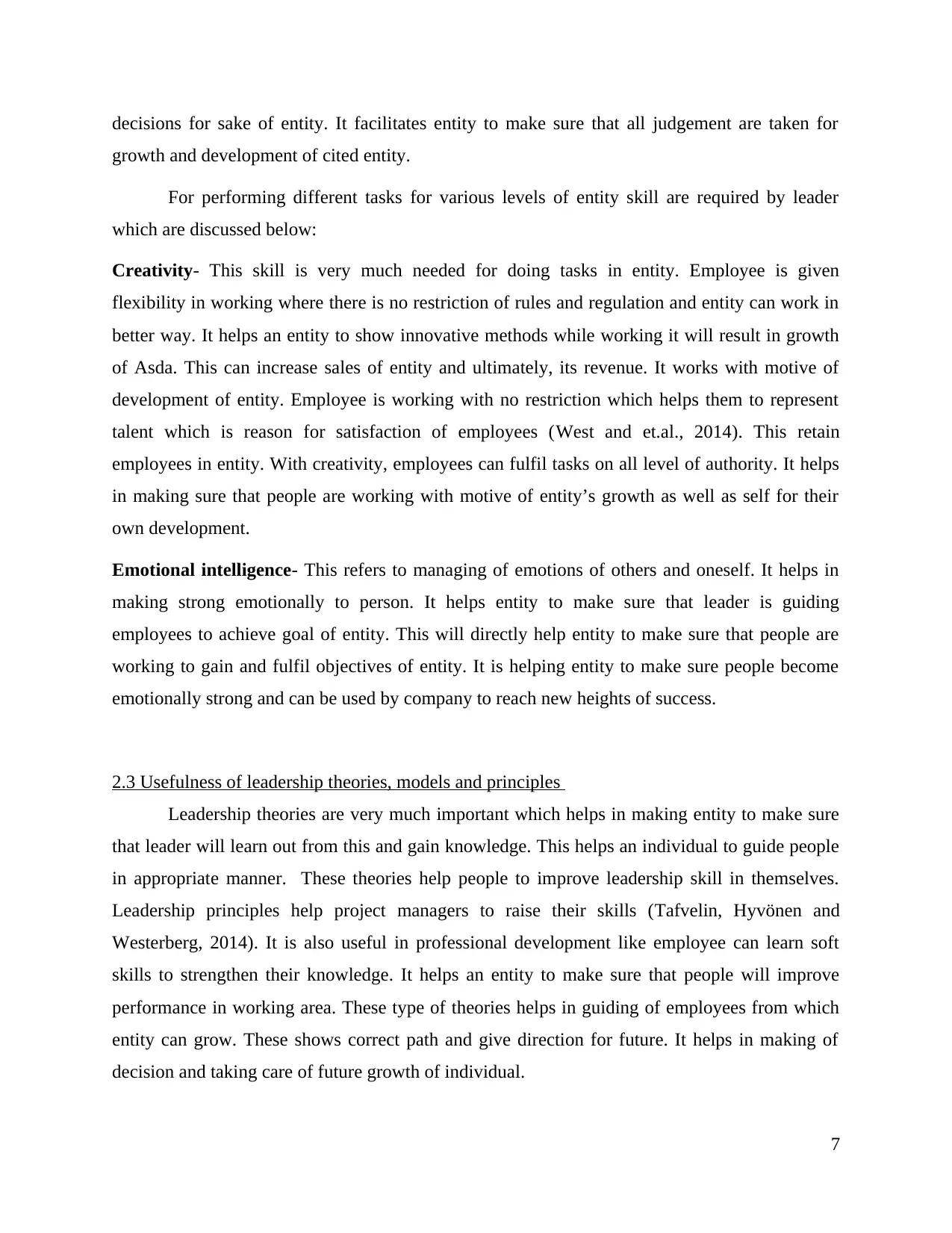
decisions for sake of entity. It facilitates entity to make sure that all judgement are taken for
growth and development of cited entity.
For performing different tasks for various levels of entity skill are required by leader
which are discussed below:
Creativity- This skill is very much needed for doing tasks in entity. Employee is given
flexibility in working where there is no restriction of rules and regulation and entity can work in
better way. It helps an entity to show innovative methods while working it will result in growth
of Asda. This can increase sales of entity and ultimately, its revenue. It works with motive of
development of entity. Employee is working with no restriction which helps them to represent
talent which is reason for satisfaction of employees (West and et.al., 2014). This retain
employees in entity. With creativity, employees can fulfil tasks on all level of authority. It helps
in making sure that people are working with motive of entity’s growth as well as self for their
own development.
Emotional intelligence- This refers to managing of emotions of others and oneself. It helps in
making strong emotionally to person. It helps entity to make sure that leader is guiding
employees to achieve goal of entity. This will directly help entity to make sure that people are
working to gain and fulfil objectives of entity. It is helping entity to make sure people become
emotionally strong and can be used by company to reach new heights of success.
2.3 Usefulness of leadership theories, models and principles
Leadership theories are very much important which helps in making entity to make sure
that leader will learn out from this and gain knowledge. This helps an individual to guide people
in appropriate manner. These theories help people to improve leadership skill in themselves.
Leadership principles help project managers to raise their skills (Tafvelin, Hyvönen and
Westerberg, 2014). It is also useful in professional development like employee can learn soft
skills to strengthen their knowledge. It helps an entity to make sure that people will improve
performance in working area. These type of theories helps in guiding of employees from which
entity can grow. These shows correct path and give direction for future. It helps in making of
decision and taking care of future growth of individual.
7
growth and development of cited entity.
For performing different tasks for various levels of entity skill are required by leader
which are discussed below:
Creativity- This skill is very much needed for doing tasks in entity. Employee is given
flexibility in working where there is no restriction of rules and regulation and entity can work in
better way. It helps an entity to show innovative methods while working it will result in growth
of Asda. This can increase sales of entity and ultimately, its revenue. It works with motive of
development of entity. Employee is working with no restriction which helps them to represent
talent which is reason for satisfaction of employees (West and et.al., 2014). This retain
employees in entity. With creativity, employees can fulfil tasks on all level of authority. It helps
in making sure that people are working with motive of entity’s growth as well as self for their
own development.
Emotional intelligence- This refers to managing of emotions of others and oneself. It helps in
making strong emotionally to person. It helps entity to make sure that leader is guiding
employees to achieve goal of entity. This will directly help entity to make sure that people are
working to gain and fulfil objectives of entity. It is helping entity to make sure people become
emotionally strong and can be used by company to reach new heights of success.
2.3 Usefulness of leadership theories, models and principles
Leadership theories are very much important which helps in making entity to make sure
that leader will learn out from this and gain knowledge. This helps an individual to guide people
in appropriate manner. These theories help people to improve leadership skill in themselves.
Leadership principles help project managers to raise their skills (Tafvelin, Hyvönen and
Westerberg, 2014). It is also useful in professional development like employee can learn soft
skills to strengthen their knowledge. It helps an entity to make sure that people will improve
performance in working area. These type of theories helps in guiding of employees from which
entity can grow. These shows correct path and give direction for future. It helps in making of
decision and taking care of future growth of individual.
7
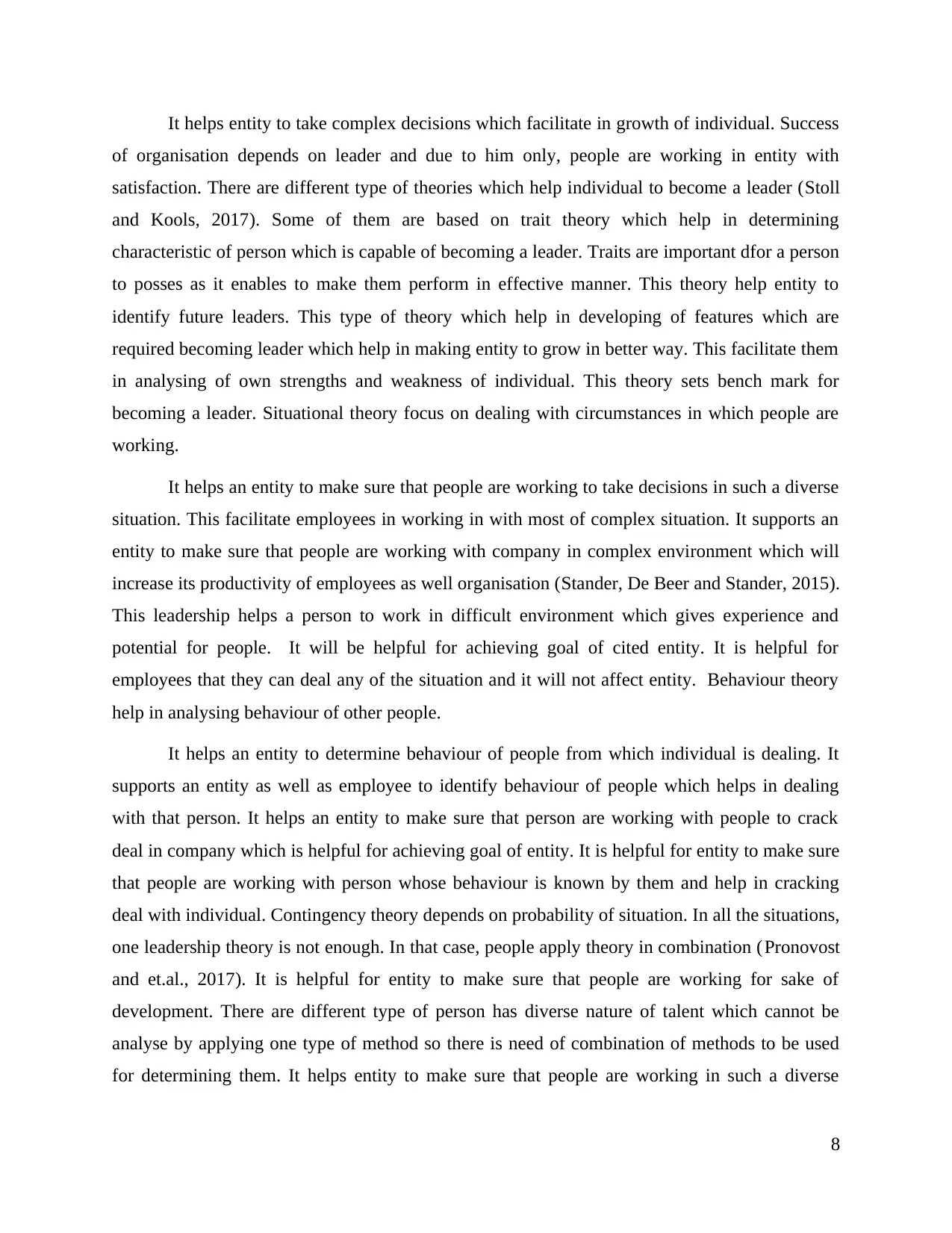
It helps entity to take complex decisions which facilitate in growth of individual. Success
of organisation depends on leader and due to him only, people are working in entity with
satisfaction. There are different type of theories which help individual to become a leader (Stoll
and Kools, 2017). Some of them are based on trait theory which help in determining
characteristic of person which is capable of becoming a leader. Traits are important dfor a person
to posses as it enables to make them perform in effective manner. This theory help entity to
identify future leaders. This type of theory which help in developing of features which are
required becoming leader which help in making entity to grow in better way. This facilitate them
in analysing of own strengths and weakness of individual. This theory sets bench mark for
becoming a leader. Situational theory focus on dealing with circumstances in which people are
working.
It helps an entity to make sure that people are working to take decisions in such a diverse
situation. This facilitate employees in working in with most of complex situation. It supports an
entity to make sure that people are working with company in complex environment which will
increase its productivity of employees as well organisation (Stander, De Beer and Stander, 2015).
This leadership helps a person to work in difficult environment which gives experience and
potential for people. It will be helpful for achieving goal of cited entity. It is helpful for
employees that they can deal any of the situation and it will not affect entity. Behaviour theory
help in analysing behaviour of other people.
It helps an entity to determine behaviour of people from which individual is dealing. It
supports an entity as well as employee to identify behaviour of people which helps in dealing
with that person. It helps an entity to make sure that person are working with people to crack
deal in company which is helpful for achieving goal of entity. It is helpful for entity to make sure
that people are working with person whose behaviour is known by them and help in cracking
deal with individual. Contingency theory depends on probability of situation. In all the situations,
one leadership theory is not enough. In that case, people apply theory in combination (Pronovost
and et.al., 2017). It is helpful for entity to make sure that people are working for sake of
development. There are different type of person has diverse nature of talent which cannot be
analyse by applying one type of method so there is need of combination of methods to be used
for determining them. It helps entity to make sure that people are working in such a diverse
8
of organisation depends on leader and due to him only, people are working in entity with
satisfaction. There are different type of theories which help individual to become a leader (Stoll
and Kools, 2017). Some of them are based on trait theory which help in determining
characteristic of person which is capable of becoming a leader. Traits are important dfor a person
to posses as it enables to make them perform in effective manner. This theory help entity to
identify future leaders. This type of theory which help in developing of features which are
required becoming leader which help in making entity to grow in better way. This facilitate them
in analysing of own strengths and weakness of individual. This theory sets bench mark for
becoming a leader. Situational theory focus on dealing with circumstances in which people are
working.
It helps an entity to make sure that people are working to take decisions in such a diverse
situation. This facilitate employees in working in with most of complex situation. It supports an
entity to make sure that people are working with company in complex environment which will
increase its productivity of employees as well organisation (Stander, De Beer and Stander, 2015).
This leadership helps a person to work in difficult environment which gives experience and
potential for people. It will be helpful for achieving goal of cited entity. It is helpful for
employees that they can deal any of the situation and it will not affect entity. Behaviour theory
help in analysing behaviour of other people.
It helps an entity to determine behaviour of people from which individual is dealing. It
supports an entity as well as employee to identify behaviour of people which helps in dealing
with that person. It helps an entity to make sure that person are working with people to crack
deal in company which is helpful for achieving goal of entity. It is helpful for entity to make sure
that people are working with person whose behaviour is known by them and help in cracking
deal with individual. Contingency theory depends on probability of situation. In all the situations,
one leadership theory is not enough. In that case, people apply theory in combination (Pronovost
and et.al., 2017). It is helpful for entity to make sure that people are working for sake of
development. There are different type of person has diverse nature of talent which cannot be
analyse by applying one type of method so there is need of combination of methods to be used
for determining them. It helps entity to make sure that people are working in such a diverse
8
Secure Best Marks with AI Grader
Need help grading? Try our AI Grader for instant feedback on your assignments.
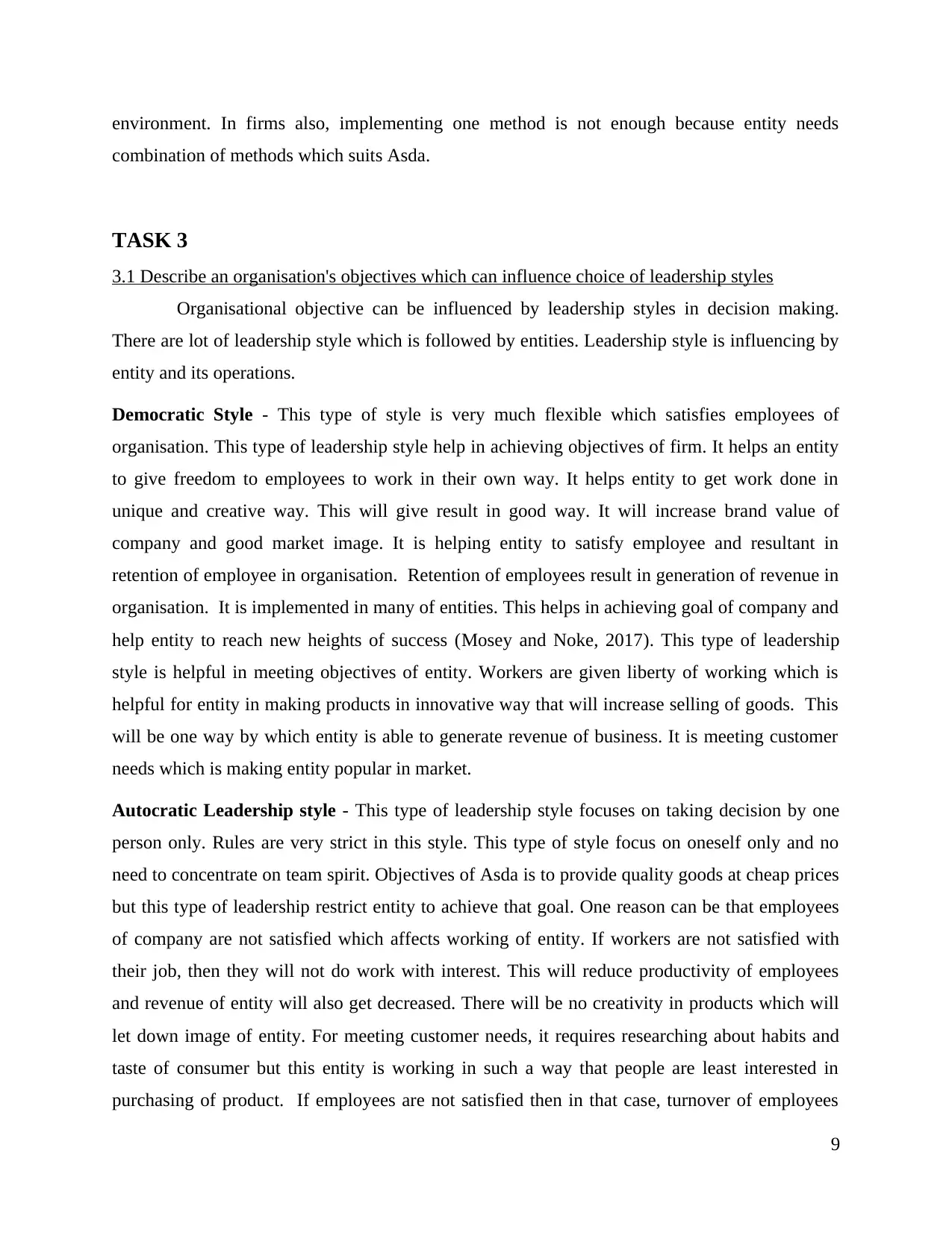
environment. In firms also, implementing one method is not enough because entity needs
combination of methods which suits Asda.
TASK 3
3.1 Describe an organisation's objectives which can influence choice of leadership styles
Organisational objective can be influenced by leadership styles in decision making.
There are lot of leadership style which is followed by entities. Leadership style is influencing by
entity and its operations.
Democratic Style - This type of style is very much flexible which satisfies employees of
organisation. This type of leadership style help in achieving objectives of firm. It helps an entity
to give freedom to employees to work in their own way. It helps entity to get work done in
unique and creative way. This will give result in good way. It will increase brand value of
company and good market image. It is helping entity to satisfy employee and resultant in
retention of employee in organisation. Retention of employees result in generation of revenue in
organisation. It is implemented in many of entities. This helps in achieving goal of company and
help entity to reach new heights of success (Mosey and Noke, 2017). This type of leadership
style is helpful in meeting objectives of entity. Workers are given liberty of working which is
helpful for entity in making products in innovative way that will increase selling of goods. This
will be one way by which entity is able to generate revenue of business. It is meeting customer
needs which is making entity popular in market.
Autocratic Leadership style - This type of leadership style focuses on taking decision by one
person only. Rules are very strict in this style. This type of style focus on oneself only and no
need to concentrate on team spirit. Objectives of Asda is to provide quality goods at cheap prices
but this type of leadership restrict entity to achieve that goal. One reason can be that employees
of company are not satisfied which affects working of entity. If workers are not satisfied with
their job, then they will not do work with interest. This will reduce productivity of employees
and revenue of entity will also get decreased. There will be no creativity in products which will
let down image of entity. For meeting customer needs, it requires researching about habits and
taste of consumer but this entity is working in such a way that people are least interested in
purchasing of product. If employees are not satisfied then in that case, turnover of employees
9
combination of methods which suits Asda.
TASK 3
3.1 Describe an organisation's objectives which can influence choice of leadership styles
Organisational objective can be influenced by leadership styles in decision making.
There are lot of leadership style which is followed by entities. Leadership style is influencing by
entity and its operations.
Democratic Style - This type of style is very much flexible which satisfies employees of
organisation. This type of leadership style help in achieving objectives of firm. It helps an entity
to give freedom to employees to work in their own way. It helps entity to get work done in
unique and creative way. This will give result in good way. It will increase brand value of
company and good market image. It is helping entity to satisfy employee and resultant in
retention of employee in organisation. Retention of employees result in generation of revenue in
organisation. It is implemented in many of entities. This helps in achieving goal of company and
help entity to reach new heights of success (Mosey and Noke, 2017). This type of leadership
style is helpful in meeting objectives of entity. Workers are given liberty of working which is
helpful for entity in making products in innovative way that will increase selling of goods. This
will be one way by which entity is able to generate revenue of business. It is meeting customer
needs which is making entity popular in market.
Autocratic Leadership style - This type of leadership style focuses on taking decision by one
person only. Rules are very strict in this style. This type of style focus on oneself only and no
need to concentrate on team spirit. Objectives of Asda is to provide quality goods at cheap prices
but this type of leadership restrict entity to achieve that goal. One reason can be that employees
of company are not satisfied which affects working of entity. If workers are not satisfied with
their job, then they will not do work with interest. This will reduce productivity of employees
and revenue of entity will also get decreased. There will be no creativity in products which will
let down image of entity. For meeting customer needs, it requires researching about habits and
taste of consumer but this entity is working in such a way that people are least interested in
purchasing of product. If employees are not satisfied then in that case, turnover of employees
9
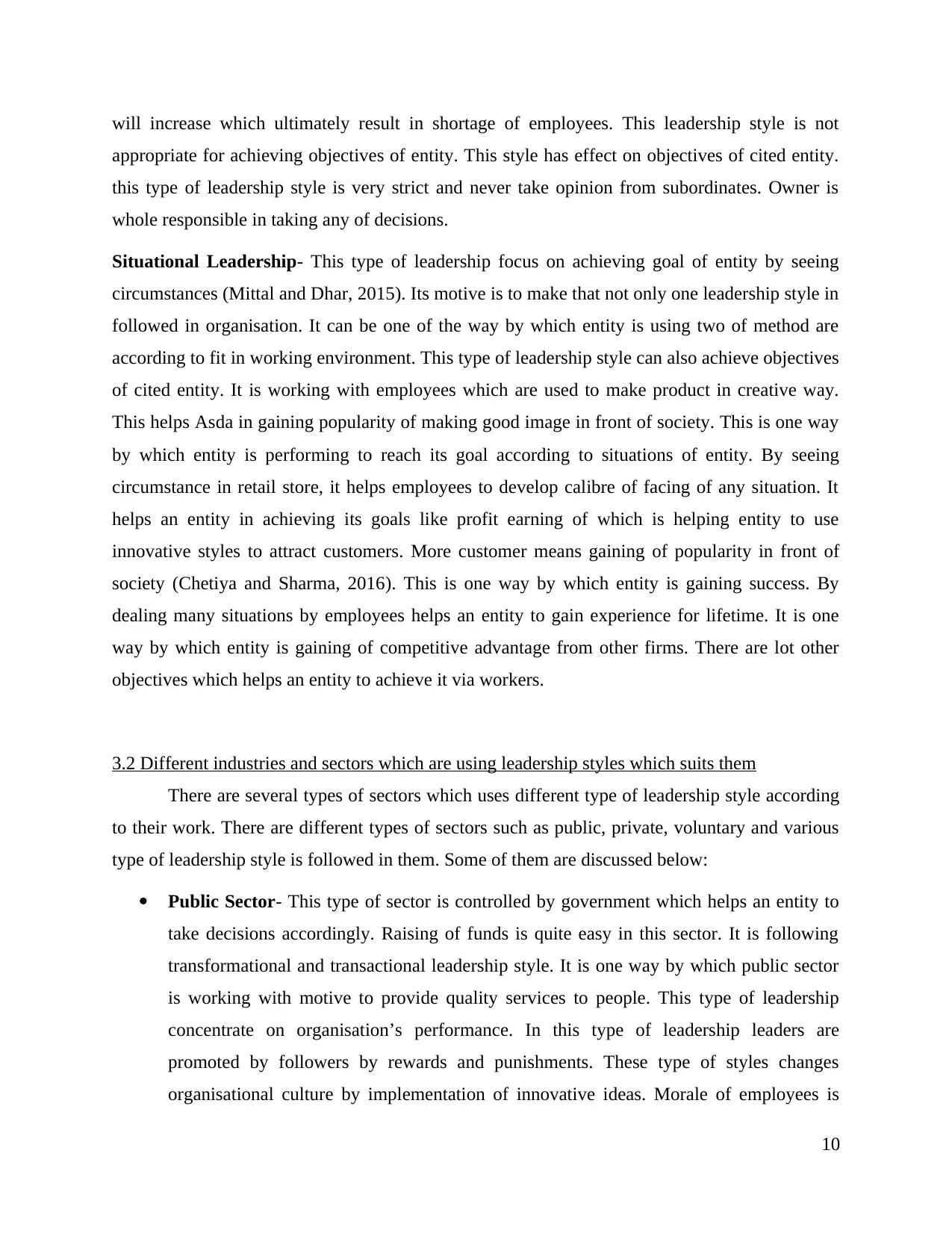
will increase which ultimately result in shortage of employees. This leadership style is not
appropriate for achieving objectives of entity. This style has effect on objectives of cited entity.
this type of leadership style is very strict and never take opinion from subordinates. Owner is
whole responsible in taking any of decisions.
Situational Leadership- This type of leadership focus on achieving goal of entity by seeing
circumstances (Mittal and Dhar, 2015). Its motive is to make that not only one leadership style in
followed in organisation. It can be one of the way by which entity is using two of method are
according to fit in working environment. This type of leadership style can also achieve objectives
of cited entity. It is working with employees which are used to make product in creative way.
This helps Asda in gaining popularity of making good image in front of society. This is one way
by which entity is performing to reach its goal according to situations of entity. By seeing
circumstance in retail store, it helps employees to develop calibre of facing of any situation. It
helps an entity in achieving its goals like profit earning of which is helping entity to use
innovative styles to attract customers. More customer means gaining of popularity in front of
society (Chetiya and Sharma, 2016). This is one way by which entity is gaining success. By
dealing many situations by employees helps an entity to gain experience for lifetime. It is one
way by which entity is gaining of competitive advantage from other firms. There are lot other
objectives which helps an entity to achieve it via workers.
3.2 Different industries and sectors which are using leadership styles which suits them
There are several types of sectors which uses different type of leadership style according
to their work. There are different types of sectors such as public, private, voluntary and various
type of leadership style is followed in them. Some of them are discussed below:
Public Sector- This type of sector is controlled by government which helps an entity to
take decisions accordingly. Raising of funds is quite easy in this sector. It is following
transformational and transactional leadership style. It is one way by which public sector
is working with motive to provide quality services to people. This type of leadership
concentrate on organisation’s performance. In this type of leadership leaders are
promoted by followers by rewards and punishments. These type of styles changes
organisational culture by implementation of innovative ideas. Morale of employees is
10
appropriate for achieving objectives of entity. This style has effect on objectives of cited entity.
this type of leadership style is very strict and never take opinion from subordinates. Owner is
whole responsible in taking any of decisions.
Situational Leadership- This type of leadership focus on achieving goal of entity by seeing
circumstances (Mittal and Dhar, 2015). Its motive is to make that not only one leadership style in
followed in organisation. It can be one of the way by which entity is using two of method are
according to fit in working environment. This type of leadership style can also achieve objectives
of cited entity. It is working with employees which are used to make product in creative way.
This helps Asda in gaining popularity of making good image in front of society. This is one way
by which entity is performing to reach its goal according to situations of entity. By seeing
circumstance in retail store, it helps employees to develop calibre of facing of any situation. It
helps an entity in achieving its goals like profit earning of which is helping entity to use
innovative styles to attract customers. More customer means gaining of popularity in front of
society (Chetiya and Sharma, 2016). This is one way by which entity is gaining success. By
dealing many situations by employees helps an entity to gain experience for lifetime. It is one
way by which entity is gaining of competitive advantage from other firms. There are lot other
objectives which helps an entity to achieve it via workers.
3.2 Different industries and sectors which are using leadership styles which suits them
There are several types of sectors which uses different type of leadership style according
to their work. There are different types of sectors such as public, private, voluntary and various
type of leadership style is followed in them. Some of them are discussed below:
Public Sector- This type of sector is controlled by government which helps an entity to
take decisions accordingly. Raising of funds is quite easy in this sector. It is following
transformational and transactional leadership style. It is one way by which public sector
is working with motive to provide quality services to people. This type of leadership
concentrate on organisation’s performance. In this type of leadership leaders are
promoted by followers by rewards and punishments. These type of styles changes
organisational culture by implementation of innovative ideas. Morale of employees is
10
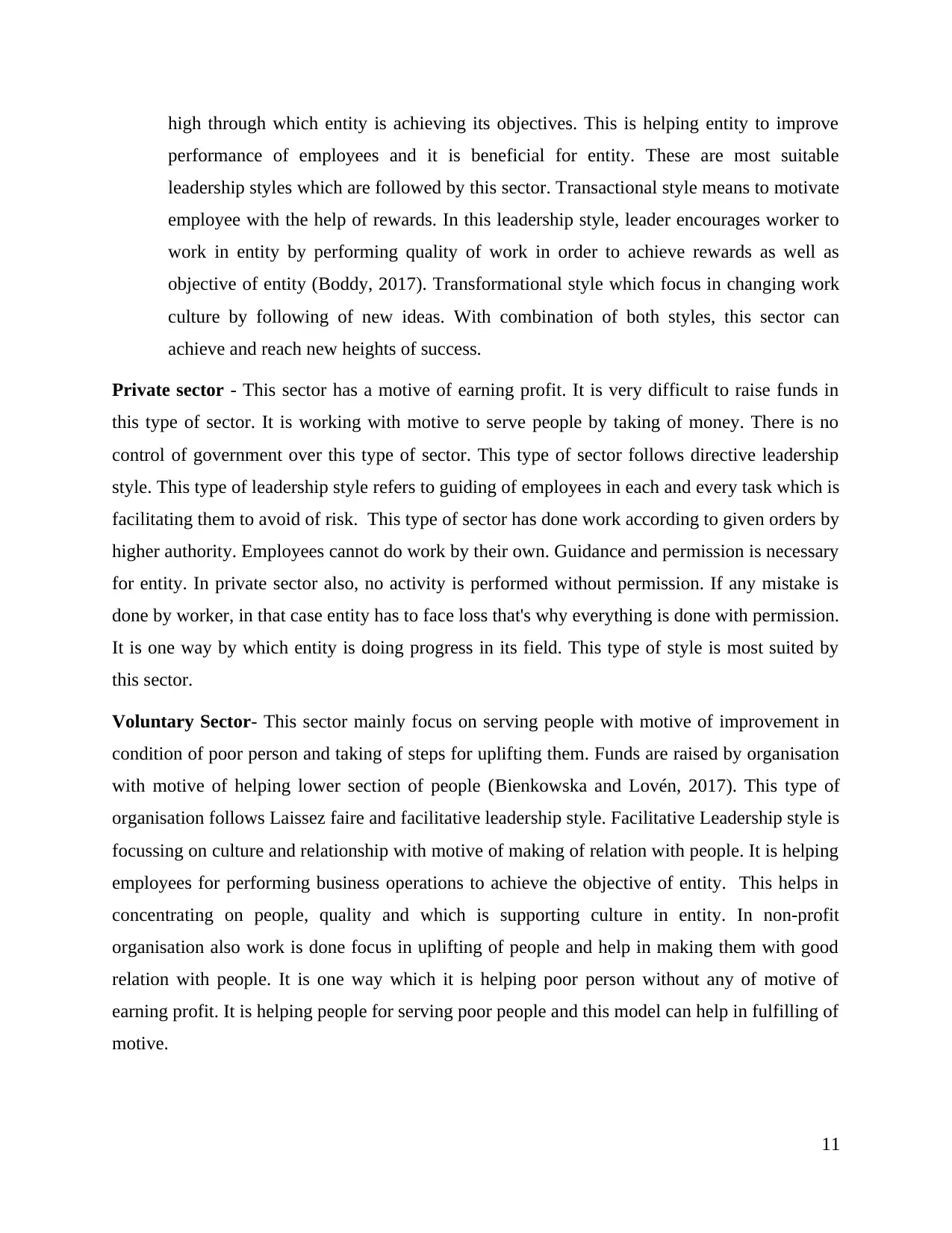
high through which entity is achieving its objectives. This is helping entity to improve
performance of employees and it is beneficial for entity. These are most suitable
leadership styles which are followed by this sector. Transactional style means to motivate
employee with the help of rewards. In this leadership style, leader encourages worker to
work in entity by performing quality of work in order to achieve rewards as well as
objective of entity (Boddy, 2017). Transformational style which focus in changing work
culture by following of new ideas. With combination of both styles, this sector can
achieve and reach new heights of success.
Private sector - This sector has a motive of earning profit. It is very difficult to raise funds in
this type of sector. It is working with motive to serve people by taking of money. There is no
control of government over this type of sector. This type of sector follows directive leadership
style. This type of leadership style refers to guiding of employees in each and every task which is
facilitating them to avoid of risk. This type of sector has done work according to given orders by
higher authority. Employees cannot do work by their own. Guidance and permission is necessary
for entity. In private sector also, no activity is performed without permission. If any mistake is
done by worker, in that case entity has to face loss that's why everything is done with permission.
It is one way by which entity is doing progress in its field. This type of style is most suited by
this sector.
Voluntary Sector- This sector mainly focus on serving people with motive of improvement in
condition of poor person and taking of steps for uplifting them. Funds are raised by organisation
with motive of helping lower section of people (Bienkowska and Lovén, 2017). This type of
organisation follows Laissez faire and facilitative leadership style. Facilitative Leadership style is
focussing on culture and relationship with motive of making of relation with people. It is helping
employees for performing business operations to achieve the objective of entity. This helps in
concentrating on people, quality and which is supporting culture in entity. In non-profit
organisation also work is done focus in uplifting of people and help in making them with good
relation with people. It is one way which it is helping poor person without any of motive of
earning profit. It is helping people for serving poor people and this model can help in fulfilling of
motive.
11
performance of employees and it is beneficial for entity. These are most suitable
leadership styles which are followed by this sector. Transactional style means to motivate
employee with the help of rewards. In this leadership style, leader encourages worker to
work in entity by performing quality of work in order to achieve rewards as well as
objective of entity (Boddy, 2017). Transformational style which focus in changing work
culture by following of new ideas. With combination of both styles, this sector can
achieve and reach new heights of success.
Private sector - This sector has a motive of earning profit. It is very difficult to raise funds in
this type of sector. It is working with motive to serve people by taking of money. There is no
control of government over this type of sector. This type of sector follows directive leadership
style. This type of leadership style refers to guiding of employees in each and every task which is
facilitating them to avoid of risk. This type of sector has done work according to given orders by
higher authority. Employees cannot do work by their own. Guidance and permission is necessary
for entity. In private sector also, no activity is performed without permission. If any mistake is
done by worker, in that case entity has to face loss that's why everything is done with permission.
It is one way by which entity is doing progress in its field. This type of style is most suited by
this sector.
Voluntary Sector- This sector mainly focus on serving people with motive of improvement in
condition of poor person and taking of steps for uplifting them. Funds are raised by organisation
with motive of helping lower section of people (Bienkowska and Lovén, 2017). This type of
organisation follows Laissez faire and facilitative leadership style. Facilitative Leadership style is
focussing on culture and relationship with motive of making of relation with people. It is helping
employees for performing business operations to achieve the objective of entity. This helps in
concentrating on people, quality and which is supporting culture in entity. In non-profit
organisation also work is done focus in uplifting of people and help in making them with good
relation with people. It is one way which it is helping poor person without any of motive of
earning profit. It is helping people for serving poor people and this model can help in fulfilling of
motive.
11
Paraphrase This Document
Need a fresh take? Get an instant paraphrase of this document with our AI Paraphraser
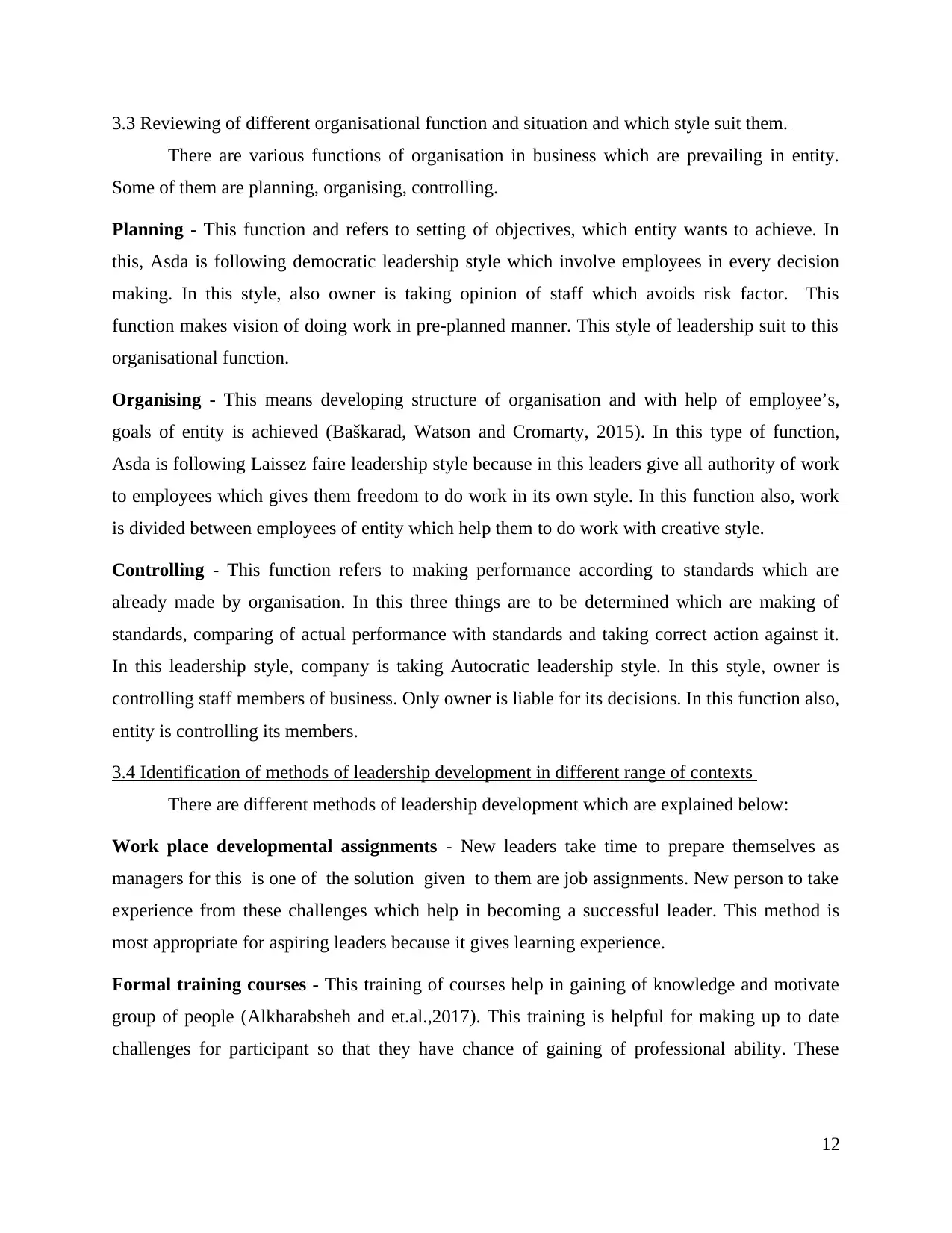
3.3 Reviewing of different organisational function and situation and which style suit them.
There are various functions of organisation in business which are prevailing in entity.
Some of them are planning, organising, controlling.
Planning - This function and refers to setting of objectives, which entity wants to achieve. In
this, Asda is following democratic leadership style which involve employees in every decision
making. In this style, also owner is taking opinion of staff which avoids risk factor. This
function makes vision of doing work in pre-planned manner. This style of leadership suit to this
organisational function.
Organising - This means developing structure of organisation and with help of employee’s,
goals of entity is achieved (Baškarad, Watson and Cromarty, 2015). In this type of function,
Asda is following Laissez faire leadership style because in this leaders give all authority of work
to employees which gives them freedom to do work in its own style. In this function also, work
is divided between employees of entity which help them to do work with creative style.
Controlling - This function refers to making performance according to standards which are
already made by organisation. In this three things are to be determined which are making of
standards, comparing of actual performance with standards and taking correct action against it.
In this leadership style, company is taking Autocratic leadership style. In this style, owner is
controlling staff members of business. Only owner is liable for its decisions. In this function also,
entity is controlling its members.
3.4 Identification of methods of leadership development in different range of contexts
There are different methods of leadership development which are explained below:
Work place developmental assignments - New leaders take time to prepare themselves as
managers for this is one of the solution given to them are job assignments. New person to take
experience from these challenges which help in becoming a successful leader. This method is
most appropriate for aspiring leaders because it gives learning experience.
Formal training courses - This training of courses help in gaining of knowledge and motivate
group of people (Alkharabsheh and et.al.,2017). This training is helpful for making up to date
challenges for participant so that they have chance of gaining of professional ability. These
12
There are various functions of organisation in business which are prevailing in entity.
Some of them are planning, organising, controlling.
Planning - This function and refers to setting of objectives, which entity wants to achieve. In
this, Asda is following democratic leadership style which involve employees in every decision
making. In this style, also owner is taking opinion of staff which avoids risk factor. This
function makes vision of doing work in pre-planned manner. This style of leadership suit to this
organisational function.
Organising - This means developing structure of organisation and with help of employee’s,
goals of entity is achieved (Baškarad, Watson and Cromarty, 2015). In this type of function,
Asda is following Laissez faire leadership style because in this leaders give all authority of work
to employees which gives them freedom to do work in its own style. In this function also, work
is divided between employees of entity which help them to do work with creative style.
Controlling - This function refers to making performance according to standards which are
already made by organisation. In this three things are to be determined which are making of
standards, comparing of actual performance with standards and taking correct action against it.
In this leadership style, company is taking Autocratic leadership style. In this style, owner is
controlling staff members of business. Only owner is liable for its decisions. In this function also,
entity is controlling its members.
3.4 Identification of methods of leadership development in different range of contexts
There are different methods of leadership development which are explained below:
Work place developmental assignments - New leaders take time to prepare themselves as
managers for this is one of the solution given to them are job assignments. New person to take
experience from these challenges which help in becoming a successful leader. This method is
most appropriate for aspiring leaders because it gives learning experience.
Formal training courses - This training of courses help in gaining of knowledge and motivate
group of people (Alkharabsheh and et.al.,2017). This training is helpful for making up to date
challenges for participant so that they have chance of gaining of professional ability. These
12
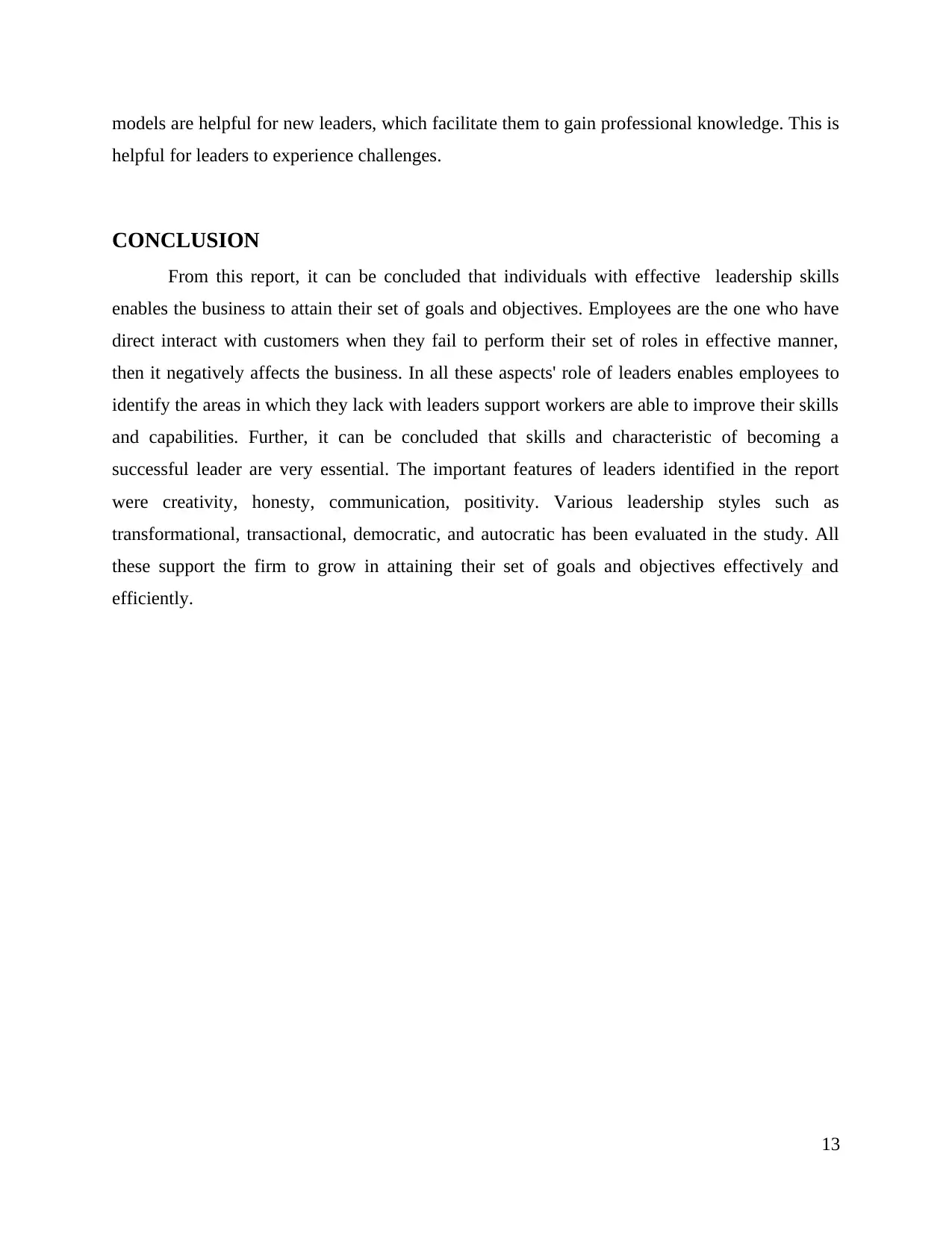
models are helpful for new leaders, which facilitate them to gain professional knowledge. This is
helpful for leaders to experience challenges.
CONCLUSION
From this report, it can be concluded that individuals with effective leadership skills
enables the business to attain their set of goals and objectives. Employees are the one who have
direct interact with customers when they fail to perform their set of roles in effective manner,
then it negatively affects the business. In all these aspects' role of leaders enables employees to
identify the areas in which they lack with leaders support workers are able to improve their skills
and capabilities. Further, it can be concluded that skills and characteristic of becoming a
successful leader are very essential. The important features of leaders identified in the report
were creativity, honesty, communication, positivity. Various leadership styles such as
transformational, transactional, democratic, and autocratic has been evaluated in the study. All
these support the firm to grow in attaining their set of goals and objectives effectively and
efficiently.
13
helpful for leaders to experience challenges.
CONCLUSION
From this report, it can be concluded that individuals with effective leadership skills
enables the business to attain their set of goals and objectives. Employees are the one who have
direct interact with customers when they fail to perform their set of roles in effective manner,
then it negatively affects the business. In all these aspects' role of leaders enables employees to
identify the areas in which they lack with leaders support workers are able to improve their skills
and capabilities. Further, it can be concluded that skills and characteristic of becoming a
successful leader are very essential. The important features of leaders identified in the report
were creativity, honesty, communication, positivity. Various leadership styles such as
transformational, transactional, democratic, and autocratic has been evaluated in the study. All
these support the firm to grow in attaining their set of goals and objectives effectively and
efficiently.
13
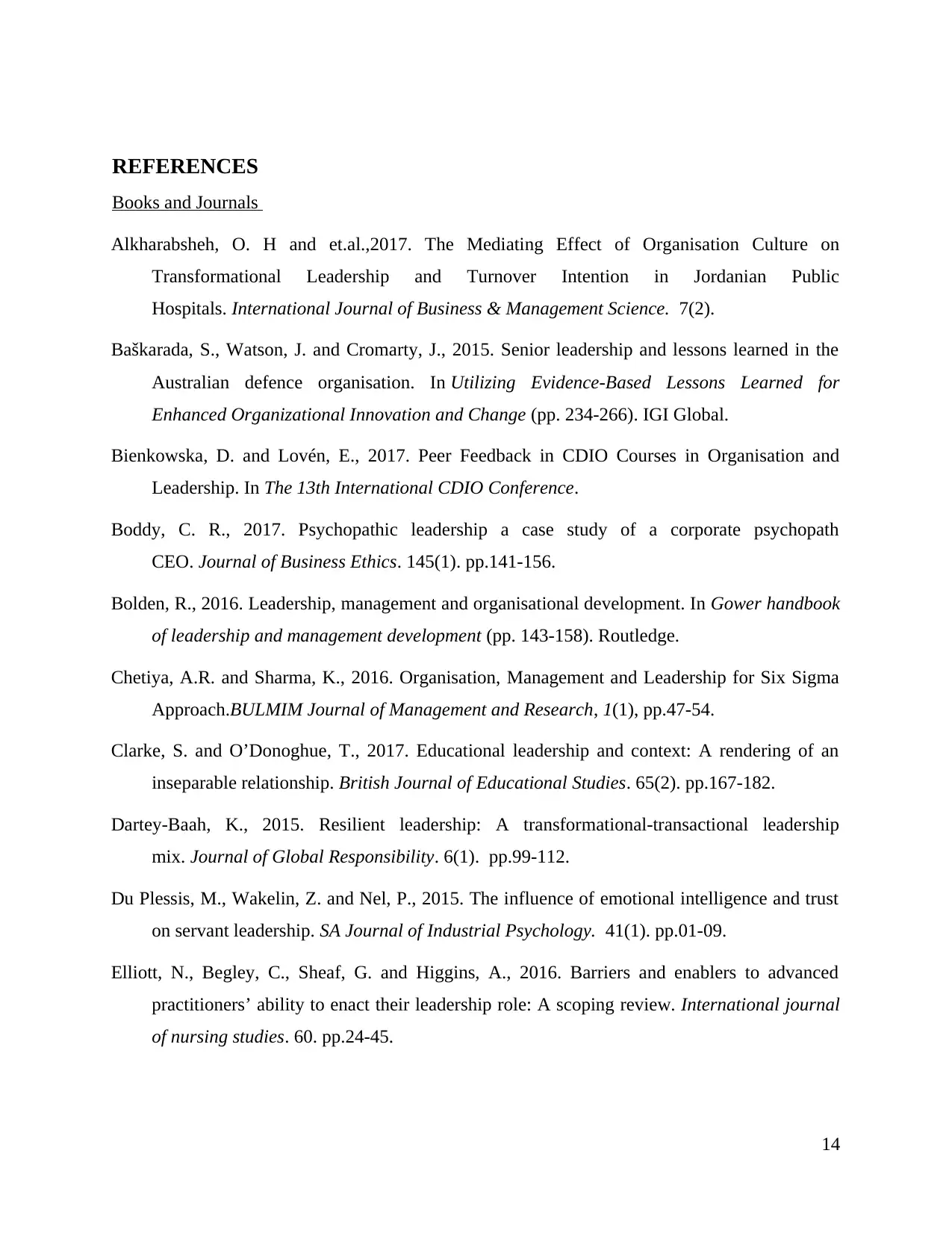
REFERENCES
Books and Journals
Alkharabsheh, O. H and et.al.,2017. The Mediating Effect of Organisation Culture on
Transformational Leadership and Turnover Intention in Jordanian Public
Hospitals. International Journal of Business & Management Science. 7(2).
Baškarada, S., Watson, J. and Cromarty, J., 2015. Senior leadership and lessons learned in the
Australian defence organisation. In Utilizing Evidence-Based Lessons Learned for
Enhanced Organizational Innovation and Change (pp. 234-266). IGI Global.
Bienkowska, D. and Lovén, E., 2017. Peer Feedback in CDIO Courses in Organisation and
Leadership. In The 13th International CDIO Conference.
Boddy, C. R., 2017. Psychopathic leadership a case study of a corporate psychopath
CEO. Journal of Business Ethics. 145(1). pp.141-156.
Bolden, R., 2016. Leadership, management and organisational development. In Gower handbook
of leadership and management development (pp. 143-158). Routledge.
Chetiya, A.R. and Sharma, K., 2016. Organisation, Management and Leadership for Six Sigma
Approach.BULMIM Journal of Management and Research, 1(1), pp.47-54.
Clarke, S. and O’Donoghue, T., 2017. Educational leadership and context: A rendering of an
inseparable relationship. British Journal of Educational Studies. 65(2). pp.167-182.
Dartey-Baah, K., 2015. Resilient leadership: A transformational-transactional leadership
mix. Journal of Global Responsibility. 6(1). pp.99-112.
Du Plessis, M., Wakelin, Z. and Nel, P., 2015. The influence of emotional intelligence and trust
on servant leadership. SA Journal of Industrial Psychology. 41(1). pp.01-09.
Elliott, N., Begley, C., Sheaf, G. and Higgins, A., 2016. Barriers and enablers to advanced
practitioners’ ability to enact their leadership role: A scoping review. International journal
of nursing studies. 60. pp.24-45.
14
Books and Journals
Alkharabsheh, O. H and et.al.,2017. The Mediating Effect of Organisation Culture on
Transformational Leadership and Turnover Intention in Jordanian Public
Hospitals. International Journal of Business & Management Science. 7(2).
Baškarada, S., Watson, J. and Cromarty, J., 2015. Senior leadership and lessons learned in the
Australian defence organisation. In Utilizing Evidence-Based Lessons Learned for
Enhanced Organizational Innovation and Change (pp. 234-266). IGI Global.
Bienkowska, D. and Lovén, E., 2017. Peer Feedback in CDIO Courses in Organisation and
Leadership. In The 13th International CDIO Conference.
Boddy, C. R., 2017. Psychopathic leadership a case study of a corporate psychopath
CEO. Journal of Business Ethics. 145(1). pp.141-156.
Bolden, R., 2016. Leadership, management and organisational development. In Gower handbook
of leadership and management development (pp. 143-158). Routledge.
Chetiya, A.R. and Sharma, K., 2016. Organisation, Management and Leadership for Six Sigma
Approach.BULMIM Journal of Management and Research, 1(1), pp.47-54.
Clarke, S. and O’Donoghue, T., 2017. Educational leadership and context: A rendering of an
inseparable relationship. British Journal of Educational Studies. 65(2). pp.167-182.
Dartey-Baah, K., 2015. Resilient leadership: A transformational-transactional leadership
mix. Journal of Global Responsibility. 6(1). pp.99-112.
Du Plessis, M., Wakelin, Z. and Nel, P., 2015. The influence of emotional intelligence and trust
on servant leadership. SA Journal of Industrial Psychology. 41(1). pp.01-09.
Elliott, N., Begley, C., Sheaf, G. and Higgins, A., 2016. Barriers and enablers to advanced
practitioners’ ability to enact their leadership role: A scoping review. International journal
of nursing studies. 60. pp.24-45.
14
Secure Best Marks with AI Grader
Need help grading? Try our AI Grader for instant feedback on your assignments.
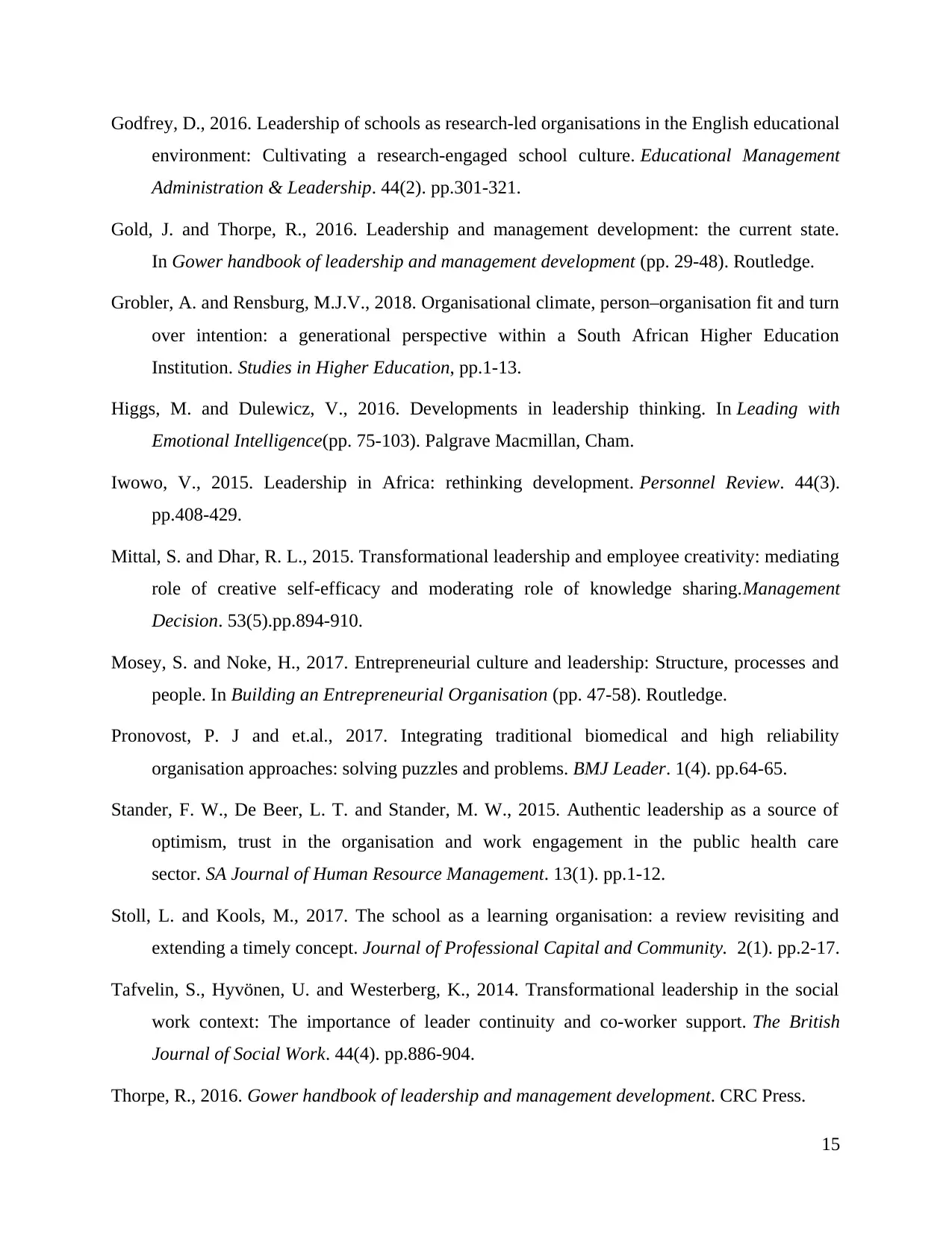
Godfrey, D., 2016. Leadership of schools as research-led organisations in the English educational
environment: Cultivating a research-engaged school culture. Educational Management
Administration & Leadership. 44(2). pp.301-321.
Gold, J. and Thorpe, R., 2016. Leadership and management development: the current state.
In Gower handbook of leadership and management development (pp. 29-48). Routledge.
Grobler, A. and Rensburg, M.J.V., 2018. Organisational climate, person–organisation fit and turn
over intention: a generational perspective within a South African Higher Education
Institution. Studies in Higher Education, pp.1-13.
Higgs, M. and Dulewicz, V., 2016. Developments in leadership thinking. In Leading with
Emotional Intelligence(pp. 75-103). Palgrave Macmillan, Cham.
Iwowo, V., 2015. Leadership in Africa: rethinking development. Personnel Review. 44(3).
pp.408-429.
Mittal, S. and Dhar, R. L., 2015. Transformational leadership and employee creativity: mediating
role of creative self-efficacy and moderating role of knowledge sharing.Management
Decision. 53(5).pp.894-910.
Mosey, S. and Noke, H., 2017. Entrepreneurial culture and leadership: Structure, processes and
people. In Building an Entrepreneurial Organisation (pp. 47-58). Routledge.
Pronovost, P. J and et.al., 2017. Integrating traditional biomedical and high reliability
organisation approaches: solving puzzles and problems. BMJ Leader. 1(4). pp.64-65.
Stander, F. W., De Beer, L. T. and Stander, M. W., 2015. Authentic leadership as a source of
optimism, trust in the organisation and work engagement in the public health care
sector. SA Journal of Human Resource Management. 13(1). pp.1-12.
Stoll, L. and Kools, M., 2017. The school as a learning organisation: a review revisiting and
extending a timely concept. Journal of Professional Capital and Community. 2(1). pp.2-17.
Tafvelin, S., Hyvönen, U. and Westerberg, K., 2014. Transformational leadership in the social
work context: The importance of leader continuity and co-worker support. The British
Journal of Social Work. 44(4). pp.886-904.
Thorpe, R., 2016. Gower handbook of leadership and management development. CRC Press.
15
environment: Cultivating a research-engaged school culture. Educational Management
Administration & Leadership. 44(2). pp.301-321.
Gold, J. and Thorpe, R., 2016. Leadership and management development: the current state.
In Gower handbook of leadership and management development (pp. 29-48). Routledge.
Grobler, A. and Rensburg, M.J.V., 2018. Organisational climate, person–organisation fit and turn
over intention: a generational perspective within a South African Higher Education
Institution. Studies in Higher Education, pp.1-13.
Higgs, M. and Dulewicz, V., 2016. Developments in leadership thinking. In Leading with
Emotional Intelligence(pp. 75-103). Palgrave Macmillan, Cham.
Iwowo, V., 2015. Leadership in Africa: rethinking development. Personnel Review. 44(3).
pp.408-429.
Mittal, S. and Dhar, R. L., 2015. Transformational leadership and employee creativity: mediating
role of creative self-efficacy and moderating role of knowledge sharing.Management
Decision. 53(5).pp.894-910.
Mosey, S. and Noke, H., 2017. Entrepreneurial culture and leadership: Structure, processes and
people. In Building an Entrepreneurial Organisation (pp. 47-58). Routledge.
Pronovost, P. J and et.al., 2017. Integrating traditional biomedical and high reliability
organisation approaches: solving puzzles and problems. BMJ Leader. 1(4). pp.64-65.
Stander, F. W., De Beer, L. T. and Stander, M. W., 2015. Authentic leadership as a source of
optimism, trust in the organisation and work engagement in the public health care
sector. SA Journal of Human Resource Management. 13(1). pp.1-12.
Stoll, L. and Kools, M., 2017. The school as a learning organisation: a review revisiting and
extending a timely concept. Journal of Professional Capital and Community. 2(1). pp.2-17.
Tafvelin, S., Hyvönen, U. and Westerberg, K., 2014. Transformational leadership in the social
work context: The importance of leader continuity and co-worker support. The British
Journal of Social Work. 44(4). pp.886-904.
Thorpe, R., 2016. Gower handbook of leadership and management development. CRC Press.
15

West, M. A. and et.al., 2014.Developing collective leadership for health care. London: King's
Fund.
Wolfgramm, R. and et.al.,, 2015. Dynamic interactions of agency in leadership (Dial): An
integrative framework for analysing agency in sustainability leadership. Journal of Business
Ethics. 126(4). pp.649-662.
Online
Leadership and Organisation. 2018. [Online]. Available through:
<https://managementstudyguide.com/leadership-ethics.htm>.
Advantages of leadership theories. 2018.[Online]. Available through:
<https://work.chron.com/advantages-emerging-leadership-theories-6325.html>.
Factor influencing leadership style. 2018. [Online] Available through:
<https://www.omicsonline.org/open-access/impact-of-leadership-style-on-organization-
performance-a-critical-literature-review-2223-5833-1000142.php?aid=58909>.
16
Fund.
Wolfgramm, R. and et.al.,, 2015. Dynamic interactions of agency in leadership (Dial): An
integrative framework for analysing agency in sustainability leadership. Journal of Business
Ethics. 126(4). pp.649-662.
Online
Leadership and Organisation. 2018. [Online]. Available through:
<https://managementstudyguide.com/leadership-ethics.htm>.
Advantages of leadership theories. 2018.[Online]. Available through:
<https://work.chron.com/advantages-emerging-leadership-theories-6325.html>.
Factor influencing leadership style. 2018. [Online] Available through:
<https://www.omicsonline.org/open-access/impact-of-leadership-style-on-organization-
performance-a-critical-literature-review-2223-5833-1000142.php?aid=58909>.
16

17
1 out of 19
Related Documents
Your All-in-One AI-Powered Toolkit for Academic Success.
+13062052269
info@desklib.com
Available 24*7 on WhatsApp / Email
![[object Object]](/_next/static/media/star-bottom.7253800d.svg)
Unlock your academic potential
© 2024 | Zucol Services PVT LTD | All rights reserved.





